

What Does a Catamaran Look Like Inside? (A Visual Guide)
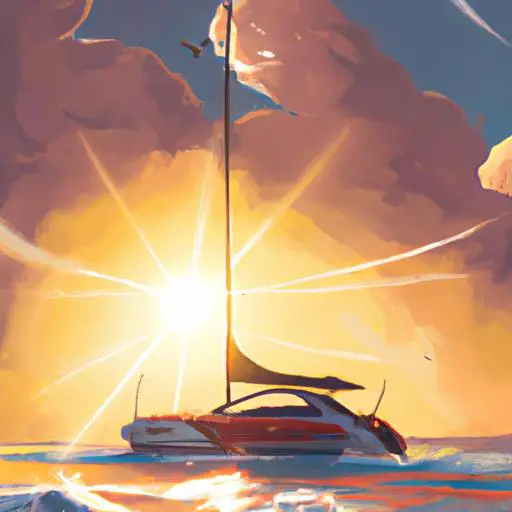
Have you ever wondered what it would be like to live on a boat? Catamarans offer an amazing opportunity to explore the open waters in style and comfort.
In this guide, we’ll take a look inside a modern catamaran and explore the features that make it so special.
From an open-plan layout to luxury bedrooms and kitchens, we’ll dive into the details of what it’s like to live on a catamaran.
We’ll also cover the flybridge, extended stays, and more.
So, let’s get started and take a look inside a catamaran!
Table of Contents
Short Answer
A catamaran typically has a spacious interior with two or three cabins, a galley, and a dining area.
Depending on the size of the catamaran, there may also be a navigation station, a wet bar, and even a lounge area.
The main living area is usually open and filled with natural light due to the large windows.
The cabins typically feature comfortable sleeping accommodations and plenty of storage for personal items.
Overview of Catamarans
Catamarans are a type of boat that have two or more hulls that are connected and outfitted with bedrooms, bathrooms, kitchens, and living spaces.
They are typically used for recreational and leisure purposes, such as cruising, sailing, and fishing.
Catamarans are known for their spacious living areas that provide plenty of seating and an open-plan layout, allowing for plenty of natural light to enter the vessel.
Many catamarans also come with a flybridge, which offers 360-degree views of the surrounding area.
Inside, catamarans are typically designed with luxury and comfort in mind, making them perfect for extended stays on the water.
Some of the features of a catamaran include a large main salon, staterooms for sleeping, full-size galley, and plenty of storage.
Additionally, catamarans are usually equipped with the latest technologies, making them an ideal choice for anyone looking for a comfortable, modern, and luxurious experience on the water.
Open-Plan Layout & Seating

Catamarans are known for their spacious interior design, with most models featuring an open-plan layout and plenty of seating.
The main living area typically includes a comfortable seating area with plenty of cushions and plush pillows, as well as several tables for dining, entertaining, and working.
The seating area may also include a sofa, loveseat, or sectional for ultimate comfort.
Many catamarans also come with a bar or countertop for additional space for serving and entertaining guests.
In addition to the seating area, catamarans also typically include several loungers, day beds, and sun pads for relaxing and soaking up the sun.
The interior of the catamaran can be configured to fit the specific needs of the owners, offering plenty of options for seating and lounging.
The open-plan layout also allows for plenty of natural light to enter the space, providing a bright and airy feel.
The interior of the catamaran is often designed with a modern, minimalist aesthetic, offering a calming and inviting atmosphere.
Bedrooms & Bathrooms
When it comes to bedrooms and bathrooms, catamarans have plenty to offer.
Many catamarans feature spacious master suites with full-sized beds, ample closet space, and even en-suite bathrooms.
Some models may even include additional guest bedrooms, perfect for larger families or groups of friends.
In terms of bathrooms, many catamarans come equipped with a separate shower and toilet, as well as plenty of counter space and storage.
Some catamarans may even have two bathrooms, allowing for added convenience and increased privacy.
When it comes to bedrooms and bathrooms, catamarans have something for everyone.
From spacious master suites to additional guest bedrooms, these vessels provide plenty of space and luxury for extended trips on the water.
With a wide variety of designs and layouts, its easy to find a catamaran that suits your needs and lifestyle.
Kitchens & Living Spaces

When it comes to the interior of a catamaran, the kitchen and living spaces are the heart of the vessel.
A catamaran typically features a fully equipped kitchen with plenty of counter space and storage, equipped with modern appliances and amenities such as a range, oven, refrigerator, and dishwasher.
For those who love to cook, a galley kitchen is the perfect place to whip up delicious meals while enjoying the views.
The living area of a catamaran is designed with luxury and comfort in mind.
With plenty of seating and open-plan layouts, its easy to find the perfect spot to relax and enjoy the scenery.
Many catamarans also feature a cozy lounge area with comfortable couches and chairs, perfect for entertaining guests and family.
And with plenty of windows to let in natural light, the interior of a catamaran feels bright and airy.
The flybridge on a catamaran offers 360-degree views of the surrounding area, making it the perfect spot for relaxation and sightseeing.
With plenty of seating and space for a small bar, its the ideal spot to watch the sunset or stargaze with friends.
And with its open-air design, the flybridge also offers plenty of natural ventilation, making it the perfect spot to enjoy a cool breeze on a hot summer day.
When it comes to catamarans, one of the most distinctive features of their design is the flybridge.
This area is located above the main living area and provides stunning 360-degree views of the surroundings.
It’s the perfect spot for taking in the sunset, star-gazing, or just enjoying the view of the horizon.
It’s also a great place to socialize with friends and family while out on the water.
The flybridge is typically equipped with comfortable seating, a sun shade, and even a sink or refrigerator to make your time on the water more enjoyable.
Depending on the size of the catamaran, the flybridge may also include a steering station and instrumentation, making it the ideal spot to pilot the vessel.
Luxury & Comfort

When it comes to luxury and comfort, catamarans dont disappoint.
The interior of a catamaran is typically designed with both of these features in mind.
From spacious living areas with plenty of seating to fully-equipped kitchens and bedrooms, catamarans are perfect for extended stays on the water.
The open-plan layout of a catamaran ensures that there is plenty of room for everyone to move around and relax.
The large windows provide plenty of natural light, making the space feel even more open and inviting.
The seating areas are designed for maximum comfort, with plush sofas and armchairs providing a relaxing spot to spend time with family and friends.
Most catamarans also come with a flybridge, which offers 360-degree views of the surrounding area.
This is the perfect spot to take in some breathtaking views while you relax in the sun.
Catamarans provide plenty of luxury and comfort for all onboard.
Whether youre looking for the perfect spot to spend a weekend away from it all or an extended stay on the water, a catamarans interior offers the perfect balance of luxury and comfort.
Extended Stays
When it comes to extended stays on the water, catamarans offer unparalleled levels of luxury and comfort.
With spacious living areas, plenty of seating, and an open-plan layout, they provide the perfect environment for long-term relaxation and exploration.
The bedrooms are typically outfitted with comfortable beds and linens, while the bathrooms feature all of the amenities of a typical home.
The kitchen is usually well-equipped with all of the appliances necessary for meal preparation, and the living area often includes a large flat-screen television and comfortable furniture.
The wide windows let in plenty of natural light, creating a bright and airy atmosphere.
This bright atmosphere is further enhanced by the presence of a flybridge, which offers 360-degree views of the surrounding area.
This allows guests to take in the beauty and serenity of their environment, no matter where they may be.
In addition to the luxury and comfort of the interior, catamarans also provide an array of recreational activities for those who wish to stay longer.
Many of these vessels come equipped with a variety of water toys, such as kayaks, paddleboards, and even small motorboats.
There are also plenty of opportunities for fishing, swimming, and exploring the local area.
All of these activities can be enjoyed from the comfort of the catamaran, making them the perfect choice for extended stays on the water.
Final Thoughts
With its open-plan layouts, luxurious bedrooms and bathrooms, spacious living areas, and 360-degree views from the flybridge, a catamaran is the perfect vessel for extended stays on the water.
Whether you’re looking for a fun day-trip or an exciting long-term adventure, a catamaran is sure to provide you with the ultimate experience.
Now that you know what a catamaran looks like inside, why not plan your own getaway today?
James Frami
At the age of 15, he and four other friends from his neighborhood constructed their first boat. He has been sailing for almost 30 years and has a wealth of knowledge that he wants to share with others.
Recent Posts
Does Your Boat License Expire? Here's What You Need to Know
Are you a boat owner looking to stay up-to-date on your license requirements? If so, youve come to the right place! In this article, well cover everything you need to know about boat license...
How to Put Skins on Your Boat in Sea of Thieves? (Complete Guide)
There is a unique sense of pride and accomplishment when you show off a boat you customized to your exact specifications. With Sea of Thieves, you can customize your boat to make it look like your...
Your source for the latest news on yachts, boats and more. Read through our articles to find out how to compare boats and find the right fit for you!
Catamaran boat interior reviews and pictures
Nov 16, 2020
less than a min
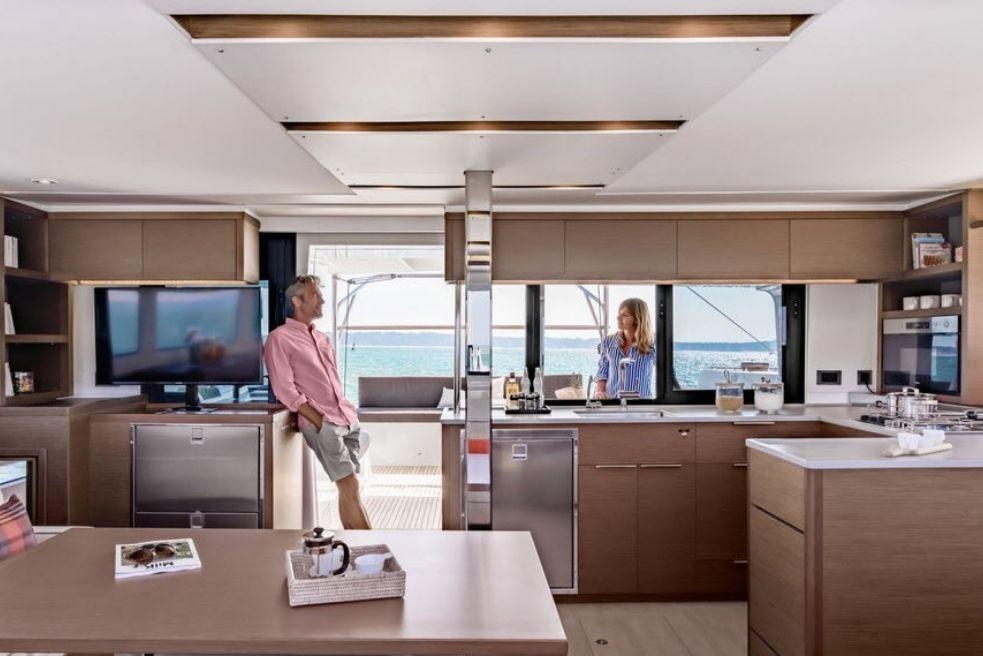
Have you ever been curious about a catamaran interior? How does everything fit in there to create comfort and even luxury and still allow catamarans to look so slim on the outside?
Here are some catamaran interior reviews to help you create a general picture of what goes on inside these peculiar vessels.
Leopard 58 catamaran interior

The Leopard 58 catamaran boat is quite a large and luxurious vessel. It has been refurbished to integrate 3 cabins, an open saloon, and a full-size owner’s suite. So, in total, this boat can accommodate 8 guests into 4 cabins. It also includes a hydraulic dinghy platform, a large flybridge where 10 people can be seated, a lounge bar and galley as well as an ample forward cockpit.
Solarwave 64 catamaran interior

The Solarwave 64 is a hybrid-yacht designed for long-range solar-cruising. It is a luxurious boat that uses only solar energy and does not need a diesel-engine to start. Its battery-capacity is designed for more than a night of permanent cruising.
The interior of this boat features polished dark wood and luxurious kitchen appliances, in addition to soft cushions for seating. The interior of the cabins follows the same language by using the same cherry colored wood as the kitchen. The ceilings remain crisp white and offer a sense of peace and serenity, by also making the entire internal space seem larger. The contrast between the wood and the while parts of the boat creates an elegant setting that can appeal to anyone’s tastes.
Lagoon 50 catamaran interior

The Lagoon 50 is a chartered catamaran boat that can be used by families and groups of friends. It includes 4+1 cabins and 4+1 toilets. This catamaran interior is clean and crisp. It shows hints of a Scandinavian style decor, with stainless steel appliances.
The Lagoon 50 interior is surrounded by windows and gains plenty of natural light that creates a peaceful atmosphere within the space. The sitting area features white fabric cushions that complement the sails. The cabins showcase hints of turquoise in the bedding which combined with the views from the portholes create a harmonious beach-like setting.
Leopard 50 catamaran interior
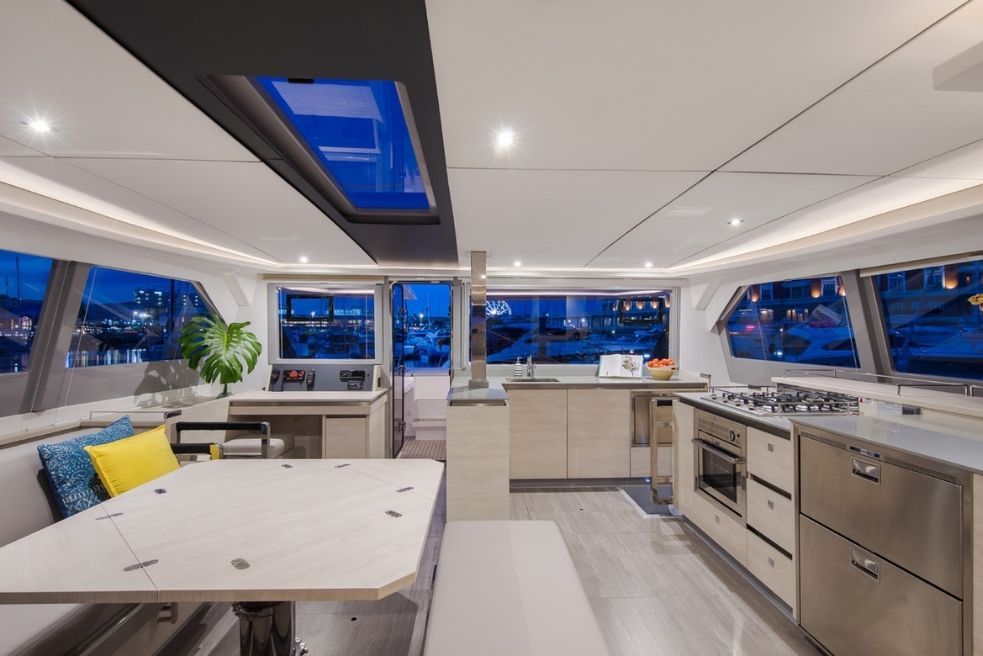
The Leopard 50 catamaran boat was re-designed to replace the Leopard 48, an award-winning boat in 2012. This is a cruising catamaran that includes a wonderful flybridge lounge.
This catamaran interior is quite modern and futuristic. It appeals to a new generation through the usage of spotlights and under-furniture LEDs that make this boat look like it jumped right off a utopic movie. The cabins show a generous size and the color palette displays a refined taste through shades of white, gray, and light brown wood.
Privilege 580 Circumnavigator catamaran interior

The Privilege 580 Circumnavigator catamaran interior is a piece of art. Its minimalistic design is complemented by a cool palette that includes shades of white, turquoise, gray, and cool brown for the wood. Everything blends together into a calming collage that tells a story: That of a charming vacation at sea. The communal spaces are fitted with anything you might need in a home. A special designer touch can be seen in the integration of orange throw pillow and turquoise table clothes that add a splash of warmth to a very clean interior.
Compare these boats on TheBoatDB, your one place where all your boating life can be stored.
You might like these too

Sailboat or Motorboat – Learn the pros and cons lg ...
Aug 24, 2022

Types of Catamaran Boats: Sailing, Power, and Luxury Catamarans lg ...
Feb 10, 2023

Which is better a wooden boat or fiberglass boat lg ...

What are the main types of sail rigs for sailboats lg ...

Which is the Best Economical Catamaran lg ...
Oct 04, 2021

What is a Chine on a Boat lg ...
Oct 01, 2021

- € 0.00 0 items
Designing the HH44 Interiors
Paul Hakes (CEO & Co-Founder of HH) and James Hakes (HH Naval Architect) in the second video of the series: how they and the team at HH Catamarans developed the all new HH44 Interiors. Welcome to “Yachting Evolved.”
Luxury Living Spaces
“The interior is where our clients live and as well as being inviting and comfortable they’ve got to be open and functional. I would like to think that after starting from the 66 seven years ago with all the models that we’ve done in between we’ve really cracked it with this one”.
“We’re quite fortunate in that all our boats are semi-customized. Despite us being an in-house design office, compared to a high volume production, we need to talk to the customer first to find out what they want, and design a functional space that suits them. That is how we developed the 44.”
“The 44 doesn’t have as much room for customization due to the price point so we had to design an interior that we could set in stone. The choices had to be limited on décor rather than arrangement and equipment.”
How it’s Arranged
“Let’s dive into the arrangement itself. On the port side as you enter the salon is the galley and it’s U-shaped. We’ve found this works really well on the 50. We’ve rotated it on the 44 but it is still fantastic on a fast moving boat that can move a bit and so you have room to brace yourself all around you.”
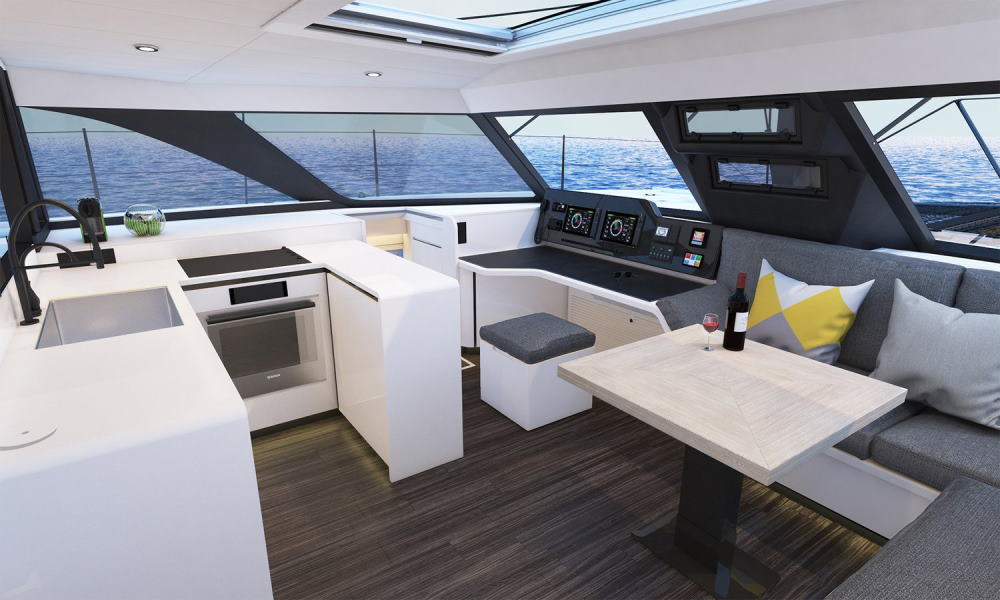
“It’s a very functional space for cooking. It’s important when you’re on passage, when even on a comfortable boat like this if you’ve got a meter or two meters of swell, the boat’s moving around.”
“Having a U-shaped galley is is a tremendous asset. We all love open spaces but on a boat, open spaces can be dangerous. There is a fine balance, a line that we had to walk when designing the interior. How much space do we offer? Lots of space looks great at a boat show but it’s not so good when you’re in the middle of the ocean when you’re trying to walk from one side to the other.”
“On the opposite side of the salon you have an L-shaped settee, two meters by two meters so you can lie down either side of it. The table even lowers into a pilot berth day bed”.
Work From Home
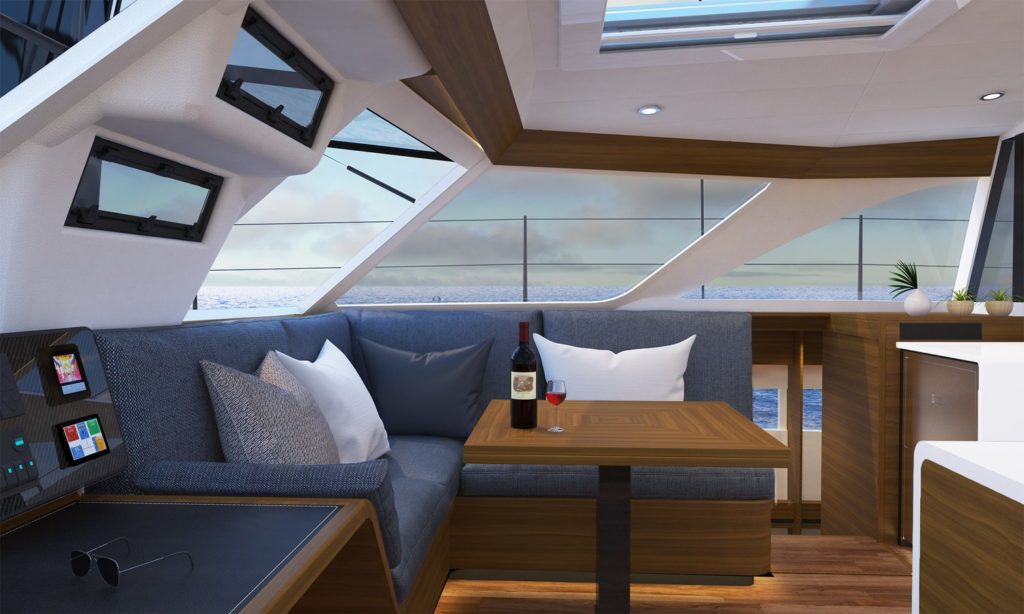
“One of my favorite areas in the salon is the nav station. You’ll notice it’s larger than on the HH50 in terms of surface area but we always seem to fill it up. I’m sure a lot of us experienced in 2020 a fair stretch of home working, and many wish they could have been working on a yacht somewhere at anchor.”
“A lot of our clients are buying boats for this very reason, so we paid a bit more attention to the nav station to make it functional not just as a navigation desk but also as an office desk, so you’ve got room for your laptop or a big screen, there’s storage and plenty of console space if you want to fit different electronics.”
Ventilation
Also in the salon, we should mention that the two forward windows swing open and that will create great ventilation. They swing forwards so when there’s light rain, you don’t have to close them. Also just behind the mast there are port lights that that actually open inwards.”
Keeping Cool
“One of the fantastic benefits of the hybrid is that in order to power it you need quite a large lithium battery bank to push the boat. In comparison to the power it takes to push the boat, air conditioners don’t use very much so, in a hypothetical scenario, if you weren’t using anything else but an air conditioner you could run it for a week non-stop.”
“Living on the boat every day you’re getting solar energy and if you are sailing the you’re charging. So you can run air conditioning all the time if you want and not have to worry about draining the batteries.”
Sleeping Well
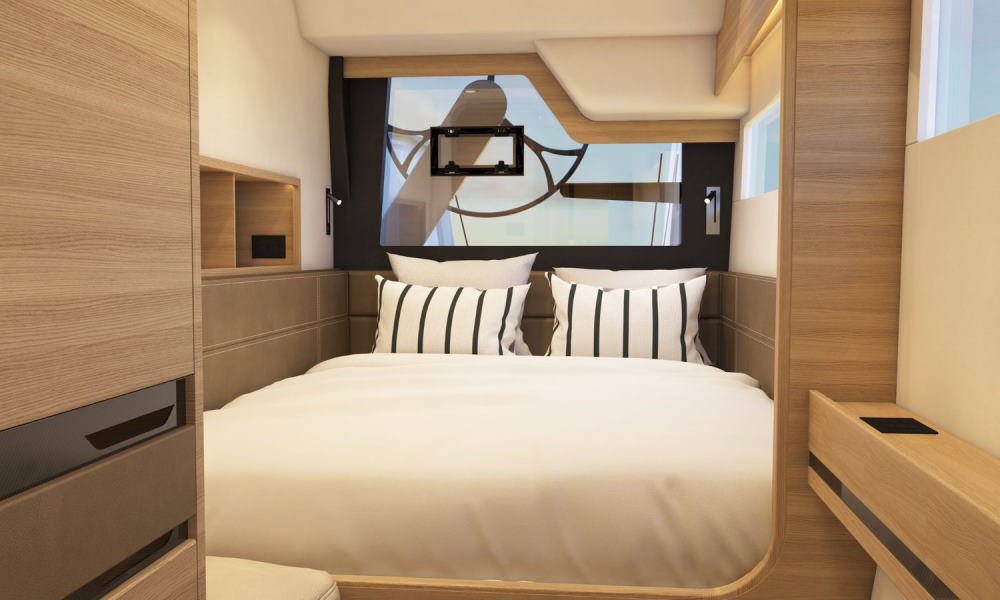
“Another important aspect of the HH44 of course is luxury. We spend 30 percent of our lives sleeping, so we use proper sprung marine mattresses with plastic springs and memory foam on the top so you sleep well.”
“Even our cushions in the salon and cockpit we’ve developed over many generations to get the right combination of open cell high density and foam with a lighter density foam on top so that it feels nice to sit in for an extended period. This is what luxury is about: beautiful sculptured foam cushions!”
“An important one because the human race as a species has got taller quite dramatically over the last 40 years, and Americans are particularly tall. In the hulls you have between six foot eight and six foot six clearance.”
“Despite the good looks of the boat, with clever design we can provide great head room. In the salon it varies from six foor eight to six foot ten. That in itself creates the feeling of luxury.”
Room for your Kit
“Storage space I consider another luxurious thing and we’ve got really big lockers at the front where we can house scuba gear and a dive compressor thanks to the hybrid electric engines.”
“Instead of the engine room, we’ve got a an empty space (well it’s got some steering gear in there and some other functions) but it’s another good cockpit storage space with a big deep locker.”
“The lockers at the front of the boat have plenty of room for all your sails and toys and if it were just a couple aboard and storage was the primary consideration we do have the option for the forward starboard cabin: you can take out the double berth there and fit it out with a workshop space with additional refrigeration.”
“And you’ve still got the aft cabin on the starboard side for your guests to come aboard with a vip double queen bed. And you’ve got overflow into the salon should people need to sleep there. So whether that space is a pantry, a workshop with lots of storage and a big working bench surface is up to you.”
“Also adding to the luxury feel of the boat we’ve paid special attention to the lighting because that’s an important part of any environment: the feeling and being able to set the mood. A harsh spotlight makes the space feel smaller so we’ve used indirect lighting wherever possible with rope lights hidden in the furniture.”
“One of the features of this that I really like is that there are RGB lights so when you’re night sailing you can set all the rope lights in the boat to red to help with your night vision.”
“That’s form and function coming together beautifully. It’s one thing to design a beautiful interior but it’s another thing to keep the design as a performance boat.”
“And you know, we have a proprietary system of making our furniture panels. They’re all foam cored and weigh just over three kilos a square meter.”
“Well I think we have touched over everything beautiful about the inside of our boats, thanks for joining and welcome to Yachting Evolved on the HH44!”
- La Grande Motte – a Coastal Gem
- Lagoon 60 Launch and Some History
- Marine Electric Engines: How They Work
- Windelo Catamaran Partner with Just Catamarans
- Excess Campus
- Lagoon Update, Oct 2023
- A New Excess Catamaran in 2024!
- New Windelo 50
- Lagoon Reaches the 500 Milestone on the 46
- Windsurf Sail Size Chart
Browse, search and find your perfect catamaran!
Privacy Overview
- Custom Cats
- Performance Cats
- Cruising Cats
- Luxury Cats
- Owner Reviews
- YT Channels
Catamaran Experience: Exploring Catamaran Interior Design

November 1, 2023

Catamarans, known for their impressive stability and spaciousness, have gained immense popularity among sailing enthusiasts and vacationers alike. These twin-hulled vessels provide an exceptional sailing experience and an even more remarkable sense of comfort and luxury, especially when it comes to their interiors. In this article, we will dive into the captivating realm of catamaran interior design, exploring the various aspects that contribute to making these vessels not only functional but also aesthetically pleasing and accommodating.
When it comes to catamaran interior design, form and function go hand in hand. The primary goal is to maximize space efficiency while ensuring a comfortable and visually appealing environment. Catamaran interiors are ingeniously designed to cater to the needs of those on board, whether for short day trips or extended voyages.
Spacious Living Areas
One of the key advantages of catamarans is their spaciousness. The wide beam between the twin hulls allows for open and airy living spaces. The main saloon, often located in the center of the catamaran, serves as the heart of the vessel. It typically features large windows that provide stunning panoramic views of the surrounding seascape. This area is perfect for dining, relaxing, and socializing with fellow passengers.
Catamaran galleys are designed with functionality in mind. The galley, where meals are prepared, is often equipped with modern appliances and ample counter space. What sets it apart is the incredible view it offers. Imagine cooking with a backdrop of sparkling blue waters and breathtaking sunsets. This unique feature adds a touch of magic to every meal and makes the galley a focal point of the catamaran interior.
Luxurious Cabins
Catamarans typically offer spacious and comfortable cabins for overnight stays. Each cabin is carefully designed to maximize comfort and privacy. The cabins often include large beds, storage space, and en-suite bathrooms, ensuring that passengers have all the amenities they need for a restful night’s sleep.
Many catamaran owners and charter companies offer options for customization and personalization. This means that you can tailor the interior of your catamaran to suit your preferences. From choosing color schemes to selecting high-quality materials and finishes, customization allows you to create a catamaran interior that reflects your individual style and taste.
Lighting and Ventilation
Proper lighting and ventilation are crucial for a comfortable catamaran interior. Large windows, hatches, and portholes are strategically place to allow natural light to flood the living spaces and provide excellent cross-ventilation. This not only enhances the overall ambiance but also reduces the need for artificial lighting and air conditioning.
Catamarans are known for their multifunctional design. Interior spaces are often designe with versatility in mind. Furniture and fixtures can be easily rearrange or stowed away to adapt to various activities, whether it’s hosting a dinner party, stowing away water sports equipment, or simply creating an open space for relaxation.
Nautical Aesthetics
Catamaran interior design often draws inspiration from nautical aesthetics. You’ll find elements such as marine-themed decor, nautical color palettes, and sleek, modern lines that complement the vessel’s exterior design. These design choices create a cohesive and visually appealing environment that resonates with the spirit of sailing.
In today’s world, sustainability is a top priority. Many catamaran owners and builders are embracing eco-friendly practices when it comes to interior design. This includes the use of sustainable materials, energy-efficient appliances, and waste reduction strategies. By making conscious choices, catamarans are not only luxurious but also environmentally responsible.
The Future of Catamaran Interior Design
As technology continues to advance, catamaran interior design is likely to evolve as well. Innovations in smart home technology, energy-efficient systems, and sustainable materials will play an increasingly significant role in shaping the future of catamaran interiors. The focus will remain on providing passengers with a comfortable and enjoyable experience while also addressing environmental concerns.
The interior design of catamarans is a captivating blend of form and function, offering passengers an exceptional sailing experience. With spacious living areas, well-equipped galleys, luxurious cabins, and the option for customization, catamarans provide a level of comfort and luxury that’s hard to match. Lighting, ventilation, and multifunctional design further enhance the overall experience, while nautical aesthetics give these vessels a unique character. As sustainability becomes more important, the industry is adapting to eco-friendly practices . With a bright future ahead, catamarans are set to continue making waves in the world of sailing and interior design.
RELATED TAGS
- create a catamaran interior
- eco-friendly practices
- exceptional sailing experience
SHARE, LIKE, REPEAT
Let's connect.
- Privacy Policy

How To Create the Perfect Cruising Catamaran Layout
As an Amazon Associate, we earn from qualifying purchases. We may also earn commissions if you purchase products from other retailers after clicking on a link from our site.
More than ever before, sailing fans are gaining an interest in catamaran layouts and designs that define performance. Many others are also looking into either buying a cruising catamaran or designing and building one. While building a catamaran is no piece of cake, this article shows you how to create the perfect cruising catamaran layout.
To create the perfect catamaran layout, carefully consider factors like a good hull design, optimal helm station placement, boat stability, and adequate load-carrying capacity. Excellent galley positioning, ease of handling, and spacious living and sleeping quarters are also crucial.
The modern cruising catamaran is a far cry from the simple Polynesian double canoe of old. That’s because structural innovations and new composite materials have resulted in multihulls with impressive cruising abilities. Keep reading to learn more about exceptional catamaran layouts.
The Changing Trends in Catamaran Designs
The early cruising catamaran designs resulted in boats that could sail much faster than traditional sailing boats. In addition, they could glide with ease in shallow waters and required less wind and crew. Unfortunately, these cruising cats were heavy, had small, cramped interiors, and boasted somewhat challenging handling abilities.
Today’s cruising catamarans are different. They boast the utmost comfort, high speeds, and the safety of a well-designed cruising yacht. They are also more exciting, visually appealing, deliver the smoothest of rides, and sport more spacious interiors.
Have a look at the below video showcasing the top ten cruising catamarans:
Features To Look Out for in Catamaran Design Layouts
Cruising catamaran designers understand what most sailors look for in a cruising vessel. They, therefore, design cruising multihulls that address these pertinent issues and more. Some of the features you might want to consider having in your dream boat include the following:
- Responsive performance. Outstanding performance allows for pleasurable cruising and ensures your safety since you have more options during difficult weather.
- Excellent load-carrying ability . This allows you to have an extended cruising vacation or ocean crossing.
- Boat stability . Go for lightweight, robust construction, which results in a lot of buoyancy.
- A low center of gravity for smooth rides and enhanced performance. Centering weight around a low center of gravity improves the overall sailing quality, reduces pitching movement and reduces the risk of capsizing .
- Adequate bridgedeck clearance to reduce slamming and provide better performance in rough conditions. A high bridgedeck also means less noise and slapping action from the waves hitting the boat bottom, thus ensuring a quieter, smoother ride.
- Comfortable sailing. To enjoy a quality life on board, you need comfort while at sea. Thus, elements like gentle movement, no creaks or groans, no bridgedeck slamming, and minimal pitching are essential for quality, peaceful and restful sleep.
Now that you know what a cutting-edge catamaran features, let’s look at how to create the perfect cruising catamaran layout.
Build a Larger-Sized Catamaran
The early catamarans ranged between 36-42 feet (10.9-12.8m). At the time, this appeared to be a good size in terms of safety and ease of handling. However, the boats were heavy, and the additional drag and displacement adversely affected their performance and windward ability.
It’s now possible to make the new generation catamarans lighter, larger, and more spacious with excellent power-to-weight features. The current trend is larger-sized catamarans in the 45-50 feet (13.7- 15.2) range. Composite engineering and technologically advanced equipment such as furling systems, electric winches, and autopilot make it easier for a smaller crew to sail larger boats with confidence. And to do so without compromising safety or stability.
Get the Best Catamaran Hull Design
A cruising catamaran’s performance depends on three main aspects; its length, the sail area, and the boat’s weight. Long boats are generally fast. A light boat with more sail area is also faster than a heavier boat with less sail area. In other words, you can make a multihull faster by making it longer, lighter, or adding more sail.
However, there are exceptions to this rule; a boat with too much sail area is more likely to capsize if there are brisk winds. Also, if the boat’s design makes it too light, it’ll be unable to handle much punishment, while a hull design that’s too slim would make the vessel incapable of carrying any significant loads. But that’s not all; if the boat is too long or too large, it’ll become grossly exorbitant. Narrow hull shape might also mean smaller cabins.
Nonetheless, these three factors alone are not enough to determine a cruising catamaran’s performance. While faster boats boast finer hulls, the wetted surface area tends to increase as fineness increases; thus, fine hulls end up becoming less fast in low wind speeds. Also, very wide hulls mean a reduction in actual performance.
The Prismatic Coefficient (Cp), a measure of how full the ends of the hull get, is the most essential design hull shape factor for any catamaran. A high Cp equals high speeds, although you can still use a lower Cp if you have fine hulls. Nevertheless, the key to a good Catamaran design is a higher Cp for fast sailing.
To achieve a high Cp, there are several things you can do:
- Fit bulb bows . Unfortunately, the bulb bows tend to slam in a seaway when you do this.
- Have an extensive planning aft section . However, this can increase the wetted surface area, WSA and lead to additional challenges.
- Flatten out the hull rocker and add a bustle aft. This helps to add displacement aft.
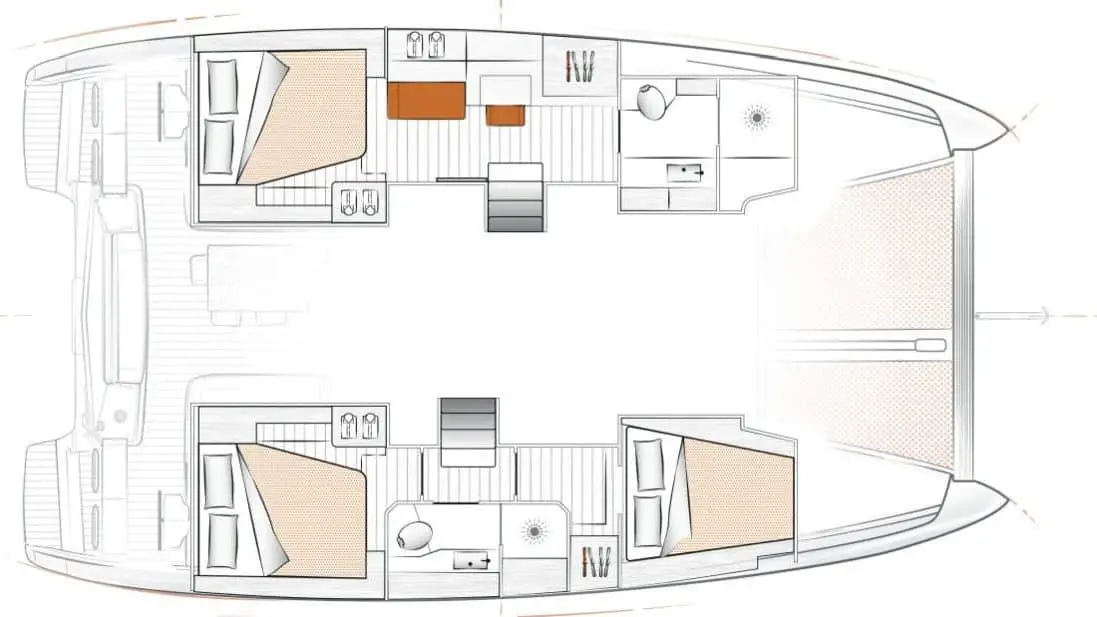
Build Convertible Main Living Spaces
The open cockpit is now a thing of the past. Instead, pioneering designers for catamaran manufacturers like Nautitech, Gunboat, and Catana now replace traditional-style salons, cockpits, and cabins with spacious indoor and outdoor living spaces. The concept involves merging separate saloon and cockpit areas with duplicate lounge spaces and the use of hard-wearing composite materials.
You can also design the cabin to suit your preferences. You may decide to add a cabin or remove one, add a bathroom, have the forward berth in the hull or on the wing deck.
- The design enhancements boost usable space while opening up the living areas.
- It reduces time and costs for interior maintenance and cleaning.
- Large windows bring in more light, increasing visibility.
- Luxurious, spacious, and airy owners’ cabins provide more comfortable living space.
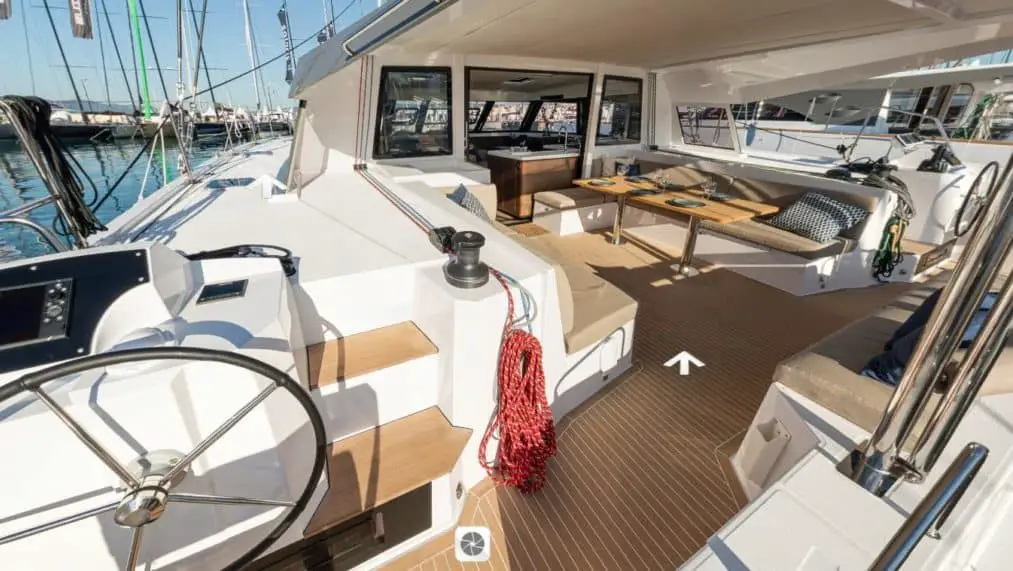
Bulkhead Helm Stations vs. Twin Stern Steering
Many catamaran owners have traditionally preferred bulkhead steering. This helm position remains popular, but twin stern steering positions come with more advantages since they provide greater sails visibility. The twin stern positions are also best suited for racing or day sailing since they often lack adequate protection for extended cruising.
Exposed helms are not ideal for a long ocean passage. Go for a safe, secure, and well-protected helm station that provides good visibility and comfortable space for long watches. Again, it’s best to have all control lines at the helm to establish a static control station. Also, have all push-button-controlled winches, instruments, windlass, and autopilot prominently located inside the cockpit.
- Twin stern steering positions give you a better view of the sails
- You get a better feel for overall sailing conditions.
- Twin stern steering positions lack the necessary protection for extended cruising.
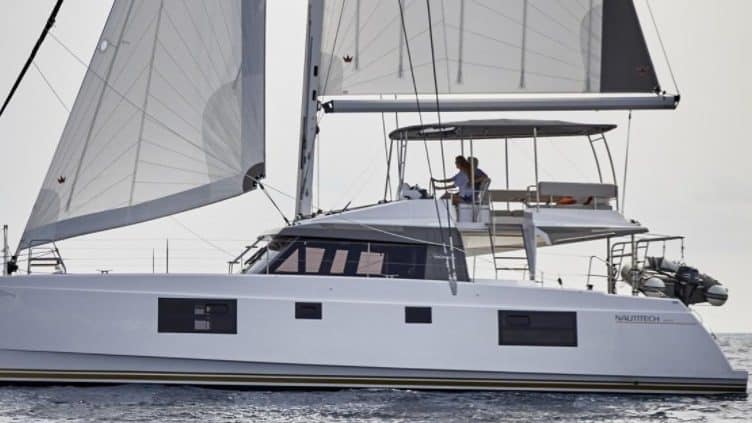
Go for the Flybridge Design
The flybridge design is appealing because it offers excellent visibility, more comfort, and additional entertainment and lounging space for everyone on board. Unfortunately for smaller boats – those below 50 feet (15.24m), there is minimal protection from the elements. As such, you might want to consider adding enclosures to offer protection. The flybridge, thus the helm, remains cut off from the vessel, which makes communicating with the crew a challenge.
- It provides great visibility.
- It offers comfortable spacing.
- It might be unsafe to move from the cockpit to the flybridge in bad weather.
- It isn’t easy to communicate with the crew.
Daggerboards vs. Fixed Keels
Average cruising catamarans typically utilize fixed keels while high-performance cats have daggerboards . Fixed keels allow you to beach your catamaran easily, and your hull remains intact if a collision occurs. While you lose some angle when sailing upwind, you gain more interior space in the hulls that you can put to good use.
Daggerboards are essential in a performance cruising catamaran since they guarantee that the boat delivers good upwind sailing, including during difficult situations. During long passages, they allow you to point better upwind though the drawback is that they consume much interior space within the cruising catamaran’s hulls.
Since flying on foils ( hydrofoils ) isn’t that practical on cruising catamarans, designers of larger-sized boats have also come up with modified daggerboards. These daggerboards produce lift and prevent leeway, too, thereby improving performance significantly, as seen with the Catana 59’s curved daggerboards. These foil-like daggerboards lift the boat ever so slightly upon reaching higher speeds, making it feel less heavy and much faster.
At the end of the day, calculating the performance of a boat sailing in a wide range of varying seas and winds might not be easy – despite a daggerboard or fixed keel configuration. This is because upwind speed depends not only on the sails’ quality but also windage and the height of the bridgedeck beyond the water.
- The design innovations -curved daggerboards and hydrofoils- improve catamaran performance significantly.
- Daggerboards enable you to access otherwise inaccessible anchorages.
- Daggerboards take up hull space in the hulls of your vessel.
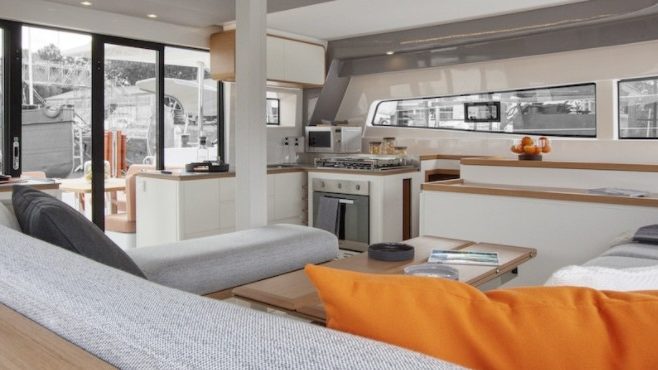
Galley Up vs. Galley Down
Galley layout are becoming more and more important as more people, including families, start sailing regularly. While at sea, your galley needs to be a safe place, well-ventilated, and functional. Everything should be well-thought-out for the sailor’s comfort, including handholds to make it safer to move around the boat.
While the galley location can either be up the bridgedeck or down in the hull, galley up appears to be the most popular trend. This makes the galley the focal point of both the living space and entertainment areas.
If you have a family, this placement is ideal since you make your meals from the galley and get to spend most of your time here. Many cruising families and couples prefer this arrangement and find separating the galley down the hull unappealing. Besides, carrying hot food up and down the staircase is unsafe.
Still, galley down is ideal for charter boats since it offers a private cooking area and uses up hull space efficiently.
- Having the galley on the bridgedeck is ideal for families and cruising couples.
- Placing the galley on a similar level with the serving area and cockpit is safer and less tiring.
- There’s better ventilation on the bridgedeck, making for comfortable cooking.
- There’s less kitchen privacy galley up.
- On smaller catamarans, this layout can impact the size of the saloon seating area significantly.
Production Catamaran vs. Custom
The choice of either a production catamaran or a custom design might seem pretty straightforward. Production catamarans from major brands come backed by proven designs, dependable construction, solid warranties, and many years of experience. The catamarans are easy to service, source for parts, and most – particularly the owner’s versions – hold on to their value, making them much easier to resell.
On their part, custom boats are fantastic in that you can tailor them to your exact needs. However, they might be more challenging to maintain or service. That’s because of parts unavailability and lack of construction knowledge.
Choose Quality Construction Materials
The best quality materials to use on your catamaran are both light and robust. While carbon fiber is great, plywood, plywood/epoxy, and strip-cedar are excellent materials too. What’s more, they are also affordable, so you don’t have to get too hung up on cutting-edge building materials. What matters is build quality; thus, a well-built plywood catamaran boat can last as long as a boat made from more high-tech materials.
Combining various materials also helps combat some of the issues that plague plywood boats in terms of resale value. At times, the design tends to make the boats appear pretty dated.
- Plywood and strip-cedar materials are affordable and provide excellent build quality.
- Plywood boats may have a lower resale value than those built with modern materials.
Consider Ease of Handling
An important factor in handling a cruising catamaran is deck layout. Most cruising catamarans sailed short-handed , so if your boat has one helm, all lines should run back here to allow for a static control station for the entire boat.
The other essential element is visibility from the helm. The 360 degrees of visibility while maneuvering, docking, or underway is crucial to your boat’s safety, as well as life and property. As such, you should be able to view both bows, or at least the pulpits and sterns, while standing at the helm. If not, you may have challenges handling the boat due to blind spots.
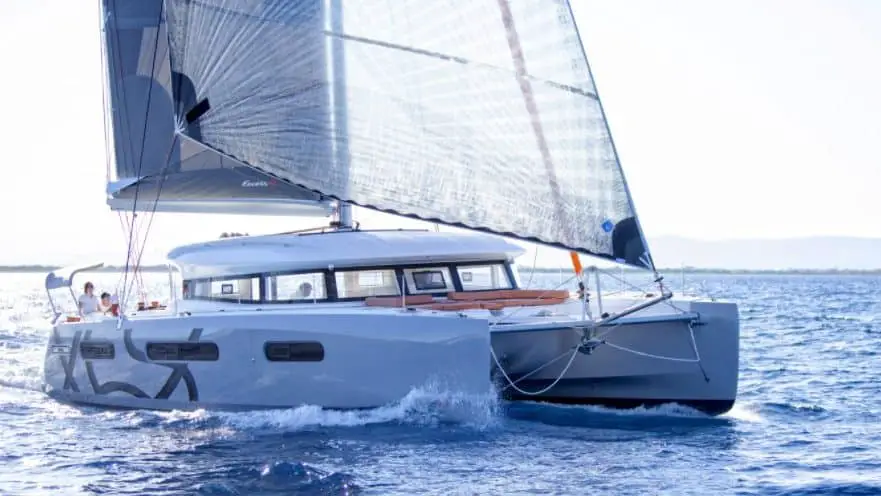
Consider the Load Carrying Capacity
A well-designed catamaran is enjoyable to sail in all weather conditions. It’s also much easier to handle than a monohull because of its widely spaced twin engines. But when you immerse extra hull depth, the vessel gets sluggish and moves slower, maneuvering in tight spots or when docking becomes more challenging. Furthermore, the hull submersion reduces bridge deck clearance, leading to hull slamming.
To allow for adequate load carrying capacity, you need a design that provides a generous displacement. This helps to ensure that you maintain reasonable bridge deck clearance even when fully loaded. It also allows you to avoid digging big holes in the water as you drag your transoms.
Displacement refers to the amount of buoyancy designed into the hulls, which essentially means that your boat will cruise better if its weight is less than your designed displacement.
Note that an overloaded catamaran not only loses out on performance but eventually, on safety too. To counter this, choose a lightweight catamaran with hulls bearing cored construction and interiors made of lightweight materials.
Remember, when you go cruising, you will need to carry fuel, extra water, supplies, equipment, and amenities, translating into thousands of extra pounds. Therefore, try and avoid the following design errors to ensure that your catamaran has an adequate load-carrying capacity:
- Avoid putting in place too much accommodation space.
- Avoid building a heavy boat ‐ use low-tech construction materials.
- Avoid installing inboards in a small boat.
- Lightly constructed catamarans perform faster and carry more weight.
- Cored construction makes for a strong and stiff catamaran, thus enabling good performance.
Final Thoughts
A well-designed cruising catamaran is a joy to behold. Today’s modern technological advancements mean that you can buy or build a light but strong cruising catamaran. And as you can see from this article, there are many excellent cruising catamaran layouts that you can choose from.
However, whichever layout you decide on needs to fit your sailing needs and purposes to ensure you remain comfortable and safe while at sea. Above all, ensure that you go for a vessel that you can handle with ease in all weather conditions.
Owner of CatamaranFreedom.com. A minimalist that has lived in a caravan in Sweden, 35ft Monohull in the Bahamas, and right now in his self-built Van. He just started the next adventure, to circumnavigate the world on a Catamaran!
Leave a Reply Cancel reply
Your email address will not be published. Required fields are marked *
Save my name and email in this browser for the next time I comment.
Recent Posts
Must-Have Boat Gear for Catamaran Sailors!
Sailing is probably the most gear-intensive activity I've ever done; there are so many decisions to be made about what gear to buy now, for tomorrow, and what to definitely never buy. The gear on...
6 Best Trailerable Trimarans For Bluewater and Coastal Sailing
Having a boat costs a lot of money, even when you are not using it, marina fees, etc. And once it is in the water most sailors never go very far from their "home marina" and sailing will be somewhat...

12 Best Catamaran Sailboats

Last Updated by
Daniel Wade
December 28, 2023
The appeal of the catamaran sailboats in terms of speed , stability, and the ability to embark on long-range cruising has made them hugely popular with today's sailors. But what are the best catamaran sailboats?
Even though catamaran sailboats have become increasingly popular in the last few years, they have a truly rich legacy as one of the most sought after vessels for bluewater cruising.
Thanks to their incredibly wide beams and bigger daft, catamarans have become remarkably favorable for sailors looking to go for long-distance voyages, overnight cruising, and day sailing.
And if space is paramount for you when out there on the water, a catamaran sailboat is the only way to go as they offer extraordinary space to allow you to spend more time on the water with friends and family.
But even with all these amazing features, you're probably still wondering; what are the best catamaran sailboats?
Like their monohull counterparts, choosing the best catamaran sailboat can be quite overwhelming since there are lots of them out there. They come in a wide variety of designs and sizes ranging from small catamarans to huge ones.
The best catamaran sailboats can easily clock 250-mile voyages, offer incredible performance, and have layouts that can be easily optimized for individuals, charter markets, and great accommodation. In essence, the best catamaran sailboats offer respectable performance and offer good load-carrying ability.
That being said, here are some of the best catamaran sailboats that you can get your hands on.
Table of contents
Best Catamarans
{{boat-info="/boats/manta-42"}}
Even though many multihulls are no longer built in the United States these days, the Manta 42 is a true American-built catamaran that brings good living and good value into one package. Designed cleverly for easy handling, this American built catamaran is a great choice for a liveaboard cruiser for sailors looking to go for long-distance voyages. Thanks to its trademark high bows and an enormously curved incorporated forward crossbeam, this catamaran is easily recognizable even from a distance.
It is designed with a uniquely fixed crossbeam, which is very different from conventional aluminum cross beams that support the tension of the forestay. This fixed crossbeam allows for a little bit of movement thereby helping in absorbing enormous twisting forces of the bows. As such, you have to keep in mind that there may be resultant stress crack particularly in the bow area of the vessel.
All in all, the Manta 42 is a superb offshore cruising catamaran that offers a good sail-area-to-displacement ratio as well as plenty of space and accommodation. The cockpit area is refined, luxurious, and is designed with additional stainless pushpit contraptions to help in holding objects such as wind vanes, dinghies, and solar panels. The boat's quality in terms of performance and stability is the benchmark of what a catamaran should be.
Fountaine Pajot Elba 45
{{boat-info="/boats/fountaine-pajot-elba-45"}}
Recently named the "Boat of the Year" for 2019 by Cruising World Magazine and Sail Magazine, the Elba 45 is the latest model in the incredible line of Fountaine Pajot catamarans. This boat was designed to replace the outgoing Helia 44 and stands to be one of the most popular catamarans with Fountain Pajot having sold over 100 Elba 45 hulls long before even the first one emerged from production.
This French-built cat brings to the fore a well-thought-out, safe, and dependable features with 10% less drag, efficient motoring, top-notch performance, and high speeds. It's also designed with fixed stub keels and slightly aft-raked bows, which are all essential in enhancing windward performance; something that most catamarans struggle with.
To improve on safety, the keels of this amazing catamaran sailboat are glued into a particularly designed recess in the hulls. This is to ensure that there are no keel bolts that can rip out and put the boat in danger if the boat gets grounded or in the event of a collision. The rig is also ICW friendly and is a true representation of a standard catamaran setup.
This is, without a doubt, a modern-looking cruising catamaran that has a low-profile lounging space on its deck, high topsides and bows as well as a more pronounced reverse sheer that's essential in minimizing the bulk of the windows while creating additional and useful volume below. This is a true catamaran that occupies a sweet spot for those looking to sail along the bay or for those adventurous sailors looking to set sail for more ambitious offshore cruising plans.
{{boat-info="/boats/leopard-48"}}
With its fine design, straightforward systems, and easy handling, the Leopard 48 has everything it needs to be ranked among the distinguished category of the best catamaran sailboats. This is an excellent multihull that is structured with advanced materials, designs, and innovations that are meant to be fun, spacious, and comfortable.
Designed in South Africa by Simonis-Voogd, is probably the best design in the Leopard family of catamarans. Its two hulls are vacuum-bagged using balsa core to offer maximum firmness while ensuring that the weight is on the minimum. This is done by articulately regulating the level of resin in the layup. With such types of hull shapes, this catamaran sailboat is very fast and can consistently clock 12 knots of speed against the currents.
The boat is also designed with shallow keels as they're filled with closed-cell polyurethane foam that's of great importance in increasing buoyancy and preventing water ingress. To enhance the safety of the vessel, the stern and bow both have bulkheads that are essential in keeping out that water if the sailboat is involved in a collision.
The hulls of this boat are deep and narrow, particularly below the waterline. They also curve higher up to practically reduce the wetted surface area while offering enough deck space and plenty of room for accommodations. Its cockpit is another excellent feature thanks to its lavish spaces that give you the chance of kicking back and relaxing.
This boat is designed to offer superior livability, quick and easy to handle features, as well as enough space for friends and family. It is designed with beautiful lines and immense practicality for those who want to go on long cruising voyages.
Antares 44i
While many people often believe that voluminous cruising catamarans should be used as charter boats, the Antares 44i brings a very different perspective altogether. Designed in Argentina as a complete bluewater catamaran, this is a boat that's specifically built for private boat owners looking for a sturdy and well-equipped bluewater cruiser. This is an absolutely gorgeous catamaran that has a fully-equipped cockpit just to ensure that you can safely operate it even when shorthanded.
Like most catamarans, the Antares 44i is designed with features that allow for long-distance voyages. It comes with a minimum bridge deck clearance of 30 inches, which is essential in mitigating bridge deck slap. The helm station is designed to offer excellent visibility over the coach roof without having to perch the helmsman high above the cockpit.
If you're planning to make those long-distance cruising to exotic places, you'll appreciate this boat's layout. The galley is put down in the port hull so that it doesn't compromise the size of the galley and the saloon. The forward-facing navigation station is up there with the best and is up to offshore standards. And that's not all; the Antares 44i comes with good mounting points for electronics, a large table, comfortable seats, and provides brilliant visibility outside.
This boat is perfectly suited for extended offshore cruising and is a great reminder for anyone who thinks that all catamarans are charter boats and all offshore boats are monohulls.
{{boat-info="/boats/dolphin-ocema-42"}}
Designed by Philipe Pouvreau in northern Brazil, the Dolphin Ocema 42 is a truly unique catamaran sailboat that goes against the conventional norm of catamarans. It is equipped with daggerboards, which are essential in enabling it to point higher on the wind while reducing the wetted surface when running or anchoring in shallow surfaces. This, however, requires a higher level of expertise in sailing. This is because lifting the daggerboards higher up will expose the rudders while the daggerboards can also interfere with the hulls in the event that the vessel runs aground.
But even with that, the Dolphin 42 balances incredible performance and cruising comfort in a very compact package; something that is not very easy in bluewater cruising. That's why it's designed using a foam core to make it lightweight by reducing weight wherever possible. This vessel will most likely never let you down if you want to circumnavigate the bluewater on a high-performance boat that is safe and comfortable.
So if you've been looking for a real sailing catamaran that doubles up as a very comfortable liveaboard sailboat , look no further than the Dolphin 42.
{{boat-info="/boats/catana-50"}}
Regarded as the best built and most stylish cruising multihull, the Catana 50 is a very huge catamaran sailboat. Measuring about 50 feet long with a beam of about 26 feet, this is an amazing catamaran that will test your sailing skills as a single sailor or if you're planning to sail shorthanded.
This boat is designed with a rig that gives you the option of using either a screecher or a self-tending jib. This may seem complex since the sheets are led to winches near each wheel while all other controls lead to a centerline winch that's located in the cockpit. But even with that, this sailboat can be easily tacked once on the course.
This is a real performance-oriented catamaran with efficient hulls and rigs allowing for top speed. This vessel is also designed with a long waterline and a subtle underwater shape at the bow to help in increasing volume while minimizing wave drag. The stern platforms can help in stretching the waterline length while also providing easy access from a dock or a dinghy. The board trunks are also very strong and sturdy to protect the integrity of the hulls if a collision occurs.
In essence, this is a very modern catamaran that's designed to safely make long-distance passages with ease. It is subdued in terms of styling but this doesn't mean that it falls short as far as performance is concerned.
Atlantic 42
{{boat-info="/boats/atlantic-42"}}
Designed in 1993, the A42 has cultivated a legion of fiercely loyal fans thanks to its efficiency and aesthetic. This is the smallest of the Atlantic cruising catamaran line and is hugely popular with sailors thanks to its ease of handling, ocean-going capabilities, and superb use of space. From the forward cockpit, pilothouse to the sleeping cabins, and brilliant galleys everything about this cat is a true classic.
Unlike most catamarans, the Atlantic 42 is designed with a waist-high cockpit that's located forward of the pilothouse just behind the mast. It brings forth a solid construction thanks to the large metal girder-like bearers that run across the bulkheads. This helps the vessel in having the utmost strength, better air circulation under the engine, and a high level of flexibility as far as the size of the engine and its positioning is concerned.
Initially, the boat's style and its outlook were considered conservative but it soon became clear that it is built of high-quality materials and to last. The internal construction of the boat is impressive, to say the least. The exterior looks very beautiful and perhaps much more beautiful than most boats today. Its large aft cabin accommodation is a top drawer while the space separating en suite heads and shower compartments are considered a bonus.
{{boat-info="/boats/fountaine-pajot-bahia-46"}}
If you were to board the French-built Fountaine Pajot Bahia 46, you'll agree that the high-quality of workmanship, layout, and efficient use of space is quite exciting, to say the least. This cat remains very popular among sailors thanks to its easy handling features and incredible performance under the sails. Well, this may not come as a surprise to many of us given that the Fountain Pajot is known for building some of the most remarkable cruising catamarans out there that it can be quite overwhelming to narrow down to a single vessel, but the Bahia 46 simply stands out.
This vessel is designed with hulls that are broader than those of many other catamarans. It's also designed with centerboards and daggerboards that are meant to enhance its performance. These are essential in minimizing draft while ensuring reliability, generous bilge, and in helping to protect the rudders and propellers.
This boat is big enough to manage any type of serious offshore sailing. This is one of the best cruising catamarans for anyone looking for the right vessel for long-distance sailing. This vessel has a very more generous rig than most cruising catamarans, which is essential in enhancing its performance. The six-post Bimini is very strong and clean and can perfectly hold dinghies.
In terms of its look, the Bahia 36 is designed with gorgeous lines with the deck and hulls sculpted with lines that add a touch of elegance to the overall look of an already excellent catamaran sailboat.
Gemini 105MC
{{boat-info="/boats/gemini-105mc"}}
Whether you're looking for a comfortable catamaran vessel to take you for a weekend sailing trip or a long sabbatical vacation on the oceans, the Gemini 105MC is a very satisfactory liveaboard catamaran vessel that offers spacious accommodation, thoughtful design, and a stable cruising platform for anyone who wants to have some good time on the water.
Designed by the legendary Tony Smith, this is somewhat a sailing cottage. Like a land cottage, it is cozy, comfortable, and very safe. This is essentially a 35 feet catamaran that offers great value for any sailing looking for a reasonably-priced catamaran sailboat for the weekend or holiday cruising.
This boat is designed with incredibly slim hulls, which are teardrop-shaped with flat bottoms and smaller wetted surface area. This is to ensure that drag is minimized and to lead to more leeway under sail. Each of the boat's hull is designed with a kick-up centerboard is of great importance in enhancing the vessel's windward pointing capability. This boat also has its rudders raised to enable it to seamlessly cruise in shallow waters where most vessels would otherwise run aground.
The eccentric narrow beam, which measures about 40% of the boat's length, is very different from today's 50%. However, its low center helps in keeping its stable, upright, and of course, safe.
Lagoon 450 F
{{boat-info="/boats/lagoon-450-f"}}
If you're looking for a catamaran sailboat that offers prestige at its peak, look no further than the Lagoon 450. This cat is widely known for offering an all-around comfort without compromising its beauty, spaciousness, class, and elegance. This is an elaborate French catamaran that brings to the table fantastic craftsmanship while leaving nothing to chance.
This is a very safe 45 feet catamaran that's not just comfortable but also very luxurious. The deck layout is centered on an amazing flybridge, which has been redesigned and redefined to offer both the traditional and modern outlook. You can very easily access the bridge, engine controls, steering station in a matter of seconds. As a result, this boat is efficiently designed to give you the ultimate control of almost every situation while on the water.
The spacious and luxurious interior of this boat is worth experiencing. The cabins and saloons are perfectly lit. We're talking about four to six cabins, eight to twelve berths, and up to four bathrooms. In essence, this boat can comfortably sleep eight to twelve people. This boat is designed to offer ultra-modern accommodations and amenities that come with little but amazing touches; all designed to make your life inside the catamaran enjoyable.
{{boat-info="/boats/gunboat-62"}}
An original performance catamaran cruiser from the iconic Gunboat manufacturer, the Gunboat 62 has truly cemented its place as one of the best catamaran sailboats to ever grace the oceans. Honestly speaking, this cat-inspired a whole range of other incredible boats including HH66 Catamaran and the Balance 526.
This is a boat that can perform admirably well in storms with a speed of over 35 knots despite being built using epoxy and E-glass with carbon-fiber structural components. It's designed with a distinct angular outline than most catamaran sailboats of its size and category. This is a vessel that was built for people looking to add more stuff and more gear for their voyages. In other words, you can have all the gear and equipment on this boat and still outperform a racing monohull of the same size.
Thanks to its lightweight feature, this vessel can sail upwind at speeds of over 17 knots and pinch up to 30 degrees. Just for comparison, the Gunboat 62 can tack through 95 degrees and still outperform the best racing monohulls. This boat is designed with a comfortable helm seat that offers 360-degree visibility as well as plenty of storage space, a functional working surface, and a luxurious cabin. Like many performance catamarans, the Gunboat 62 can attain about 20 knots if the conditions are right.
Privilege 615
{{boat-info="/boats/privilege-615"}}
Combining elegance, comfort, and style, the Privilege 615 is a lovely catamaran sailboat that seems to be always ready for a long offshore voyage. The roots of this incredible cat can be traced back to the 1980s when Philippe Jeantot opened up a boat-building company in France. As one of the best productions from the company, the privilege 615 sports a flybridge that comes complete with twin wheels, a sprawling sunbed, and other excellent features that will make your bluewater cruising a breeze.
Whether you want the charter version or a privately-owned version, the Privilege 615 is one of the most versatile catamaran sailboats. Step inside this vessel and you'll instantly notice the quality of the wood finish and the elegance of design. The advanced navigation station is not only ultra-modern but is perfectly stationed at a dedicated corner where you can control everything while still having a conversation with your friends and family.
This boat comes with multiple sleeping configurations to ensure that you and your guests can live aboard the boat for months on end. Although the boat appears like some sort of maze on the inside, you'll easily get used to it when you enter the forward section. That's not all; this boat has gorgeous lines that make the exterior beautiful just like the interior. Its sleek profile, incredible volume, and versatile interior make it one of the best catamaran sailboats out there.
There you have it; these are the best catamaran sailboats out there. It doesn't matter the one you choose, these cats will make your day out on the water and will serve you just right for your offshore voyages or for day sailing along the bays.
Related Articles
I've personally had thousands of questions about sailing and sailboats over the years. As I learn and experience sailing, and the community, I share the answers that work and make sense to me, here on Life of Sailing.
by this author
Best Sailboats
Most Recent

What Does "Sailing By The Lee" Mean?
October 3, 2023

The Best Sailing Schools And Programs: Reviews & Ratings
September 26, 2023
Important Legal Info
Lifeofsailing.com is a participant in the Amazon Services LLC Associates Program, an affiliate advertising program designed to provide a means for sites to earn advertising fees by advertising and linking to Amazon. This site also participates in other affiliate programs and is compensated for referring traffic and business to these companies.
Similar Posts

Affordable Sailboats You Can Build at Home
September 13, 2023

Best Small Sailboats With Standing Headroom

Best Bluewater Sailboats Under $50K
Popular posts.

Best Liveaboard Catamaran Sailboats

Can a Novice Sail Around the World?
Elizabeth O'Malley
June 15, 2022

4 Best Electric Outboard Motors

How Long Did It Take The Vikings To Sail To England?

10 Best Sailboat Brands (And Why)
December 20, 2023

7 Best Places To Liveaboard A Sailboat
Get the best sailing content.
Top Rated Posts
Lifeofsailing.com is a participant in the Amazon Services LLC Associates Program, an affiliate advertising program designed to provide a means for sites to earn advertising fees by advertising and linking to Amazon. This site also participates in other affiliate programs and is compensated for referring traffic and business to these companies. (866) 342-SAIL
© 2024 Life of Sailing Email: [email protected] Address: 11816 Inwood Rd #3024 Dallas, TX 75244 Disclaimer Privacy Policy

Mastering Catamaran Sailing: Essential Guide & Tips to Navigate the Waters
Alex Morgan
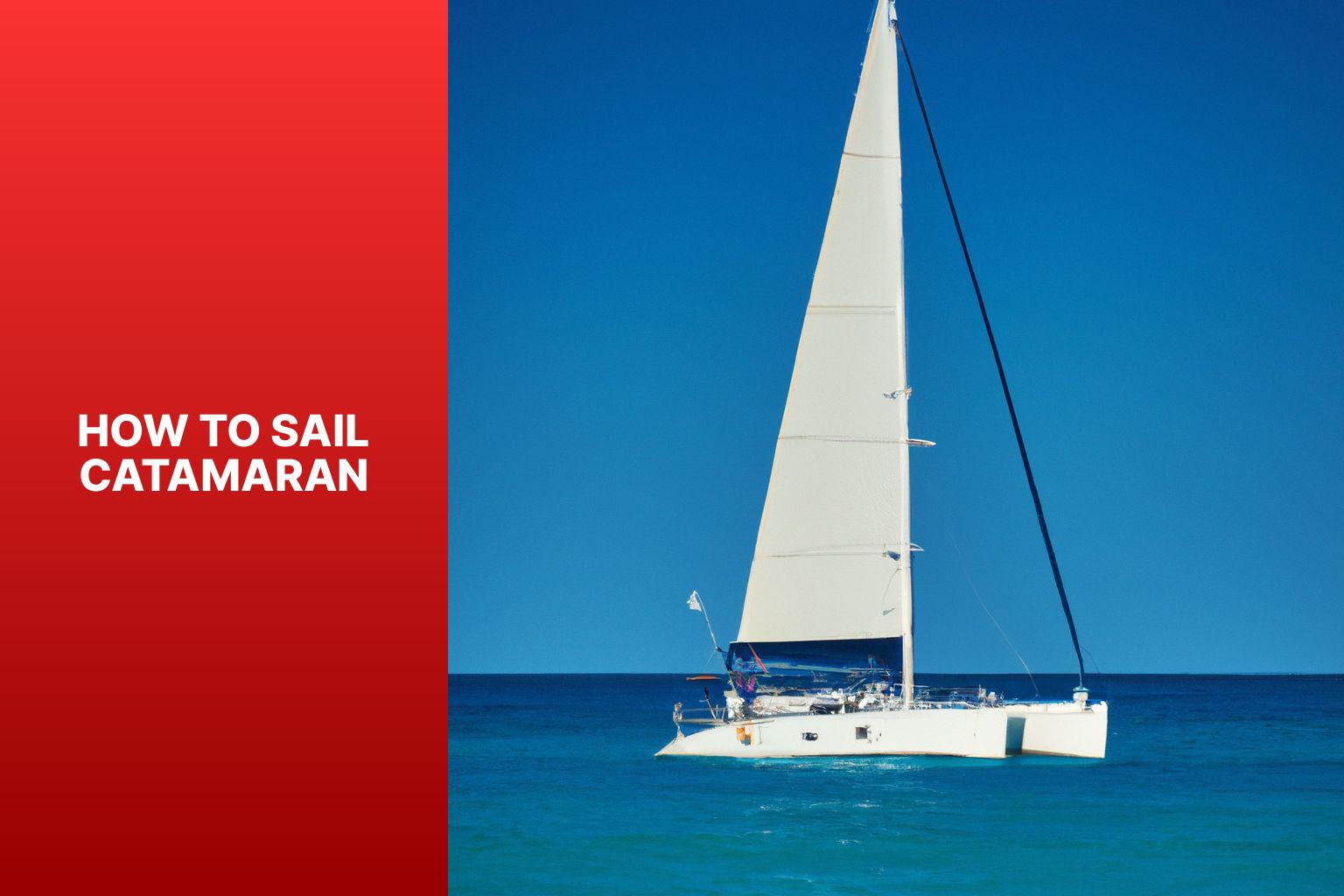
Sailing a catamaran can be an exhilarating and enjoyable experience for both experienced sailors and beginners alike. Unlike monohull sailboats, catamarans offer unique advantages in terms of stability and speed. If you’re interested in learning how to sail a catamaran, it’s important to understand the basics and master the necessary skills. This article will provide you with a comprehensive guide to sailing a catamaran, from understanding the fundamentals to maneuvering and handling the boat effectively.
To begin with, let’s delve into the introduction of sailing a catamaran, followed by understanding the basics of a catamaran. We’ll explore what exactly a catamaran is and how it differs from a monohull sailboat. we’ll discuss the advantages of sailing a catamaran, highlighting why it has become a preferred choice for many sailors.
Before setting sail, proper preparation is essential. This section covers the importance of safety equipment and checks, along with understanding wind and weather conditions. Planning your route is crucial to ensure a smooth and enjoyable sailing experience.
Once you’re prepared, we’ll move on to the essential sailing techniques for a catamaran. This section will guide you through rigging and hoisting the sails, tacking and jibing, trimming the sails, and controlling speed and direction. Mastering these techniques is key to maneuvering the catamaran effectively on the water.
Handling the catamaran also requires specific techniques. We’ll cover important maneuvers such as docking and undocking, mooring and anchoring, and addressing emergencies like man overboard recovery. These skills are vital to ensure a safe and successful journey.
We’ll provide you with essential safety tips for sailing a catamaran. Understanding right-of-way rules, handling rough seas and heavy winds, and maintaining balance and stability are crucial aspects of staying safe on the water.
By the end of this comprehensive guide, you’ll have a solid understanding of how to sail a catamaran and be well-equipped to embark on your own catamaran adventures while ensuring a safe and enjoyable experience.
– Sailing a catamaran offers the advantage of maximizing space with its two hulls, allowing for more comfortable living quarters and a larger deck area. – Catamarans provide a stable and balanced sailing experience, making them a safer option for beginners and those prone to seasickness. – Proper preparation, including checking safety equipment, understanding weather conditions, and planning your route, is crucial for a successful catamaran sailing experience.
Understanding the Basics of a Catamaran
Understanding the basics of a catamaran is essential for safe and enjoyable sailing. A catamaran is a boat with two parallel hulls connected by a deck. It has advantages over monohull boats. Catamarans are stable due to their wide beam, reducing the risk of capsizing . They can access shallow waters because of their shallow drafts . Catamarans also offer more space and comfort with larger cabins, living areas, and deck space.
To control a catamaran, the skipper uses the helm to control the rudders. Adjusting and trimming the sails allows the skipper to use the wind’s power and steer the boat efficiently. Balancing the sails and maintaining stability while sailing is important.
Knowing the key components, how to control the boat, and handle the sails will help you navigate the waters confidently. Whether you’re a seasoned sailor or a beginner, familiarizing yourself with the fundamentals of catamarans is crucial.
What Is a Catamaran?
A catamaran, also known as a cat , is a type of boat that features two parallel hulls connected by a platform or bridge deck. This unique design provides it with stability and speed, making it a popular choice for sailing enthusiasts. Unlike traditional monohull sailboats, a catamaran offers a wider beam , which results in more space and greater stability . As a result, the sailing experience on a catamaran is smoother and more comfortable .
There are several advantages to sailing a catamaran. One significant advantage is its shallow draft , which allows it to navigate in shallower waters that are inaccessible to other types of boats. The dual hull design of a catamaran minimizes drag and enhances speed , making it highly efficient for long-distance cruising . The spacious interior layout of a catamaran provides ample room for accommodations , amenities , and storage .
When sailing a catamaran, it is essential to consider the wind and weather conditions for safe navigation. Understanding the right of way rules and knowing how to handle rough seas and heavy winds are crucial skills for catamaran sailors. Maintaining balance and stability is of utmost importance to ensure a smooth sailing experience.
A fun fact about catamarans is that they have been utilized by Polynesian cultures for centuries, proving their effectiveness and versatility in various sailing conditions.
How Is a Catamaran Different from a Monohull Sailboat?
A catamaran is different from a monohull sailboat in several ways. A catamaran has two parallel hulls connected by a deck or bridge, whereas a monohull sailboat only has one hull. This dual hull design provides greater stability and balance on the water.
In addition, the hulls of a catamaran are wider and shallower compared to those of a monohull, allowing for a shallower draft and improved maneuverability . This also results in a higher cruising speed and faster sailing speeds for catamarans.
Catamarans also offer more interior space and are known for their spaciousness and comfort , thanks to their wider beam. When sailing upwind, catamarans experience less heeling , which translates into a smoother and more comfortable ride for passengers.
Catamarans are better suited for cruising in shallow waters and can anchor closer to shore due to their shallow draft . The dual hull design of catamarans also provides greater redundancy and safety in the event of hull damage or collision.
Unlike monohull sailboats, which typically have a keel, catamarans rely on centerboards or daggerboards to prevent sideways sliding. The main differences between a catamaran and a monohull sailboat lie in their stability , speed , comfort , and maneuverability .
Advantages of Sailing a Catamaran
– Stability: Catamarans offer excellent balance with their twin hulls, making them less likely to tilt or capsize compared to monohull sailboats.
– Spaciousness: The wide beam of catamarans provides more interior and deck space, including comfortable living quarters, larger cabins, and ample room for socializing and entertaining.
– Speed: The design of twin hulls reduces drag, allowing catamarans to sail faster and provide exhilarating experiences.
– Shallow Draft: Catamarans have a shallower draft than monohull sailboats, enabling them to sail in shallower waters and access a wider range of cruising grounds.
– Comfort: The wide beam and stable design of catamarans offer a smoother and more comfortable sailing experience, eliminating the heeling common in monohull sailboats and reducing the chances of seasickness.
– Maneuverability: Catamarans are more maneuverable than monohull sailboats, providing better turning ability for navigating tight spaces, docking, and anchoring precision.
– Sailing Performance: Catamarans excel in light wind conditions, thanks to their large sail area and light weight, allowing them to catch even the slightest breeze and maintain good boat speed. This makes them ideal for destinations with calm weather patterns.
Preparing for Sailing a Catamaran
Preparing for a thrilling catamaran sailing adventure requires careful planning and essential knowledge. As we dive into the section on “ Preparing for Sailing a Catamaran ,” we’ll explore vital aspects such as safety equipment and checks , understanding wind and weather conditions , and planning your route . Get ready to uncover expert tips and strategies to ensure a smooth and enjoyable catamaran journey on the open waters.
Safety Equipment and Checks
Prioritize safety when sailing a catamaran. Thoroughly check and prepare your safety equipment before setting off on your adventure. Consider the following important safety equipment and checks :
- Life jackets: Ensure enough properly fitting life jackets for everyone on board.
- Flotation devices: Have throwable flotation devices readily available for emergencies.
- Fire extinguishers: Have the appropriate type and number of fire extinguishers on board.
- First aid kit: Maintain a well-stocked kit for handling minor injuries or medical emergencies.
- Navigation lights: Ensure all navigation lights are functioning properly, especially for sailing at night or in low visibility conditions.
- Communication devices: Carry reliable communication devices such as a marine VHF radio or satellite phone for calling for help if needed.
- Engine and safety equipment checks: Regularly inspect engines, bilge pumps, anchor systems, and other safety equipment to ensure good working condition.
Remember, safety is crucial. Check your safety equipment before every trip and ensure proper working order. Familiarize yourself with specific safety requirements and regulations of the sailing area. By taking these precautions, you can enjoy your catamaran sailing adventure with peace of mind and be prepared for any unexpected situations.
Understanding Wind and Weather Conditions
Understanding wind and weather conditions is crucial when sailing a catamaran. You must have a comprehensive understanding of the wind direction, speed, and weather changes that may impact your sailing experience. Here are some key considerations to keep in mind:
1. Wind direction: It is essential to know the direction from which the wind is blowing. This knowledge will assist you in planning your sailing route and selecting the appropriate sails.
2. Wind speed: Pay close attention to the wind speed as it could potentially affect the speed and maneuverability of your boat. Higher wind speeds may necessitate reefing the sails or adjusting your course.
3. Weather changes: Remain mindful of any approaching storms, rain, or fog. These conditions can have a significant impact on visibility and create challenges when sailing.
4. Sea state: Take note of the current sea state, which includes wave height and frequency. Rough seas may require you to adjust your sailing technique and speed to ensure the stability of the catamaran.
5. Weather forecasts: Always remember to check the weather forecasts before embarking on your sailing trip. This will provide you with an overview of the expected weather conditions.
By possessing a thorough understanding of wind and weather conditions, you can make well-informed decisions to ensure a safe and enjoyable sailing experience aboard a catamaran. Keep in mind that conditions at sea can change rapidly, so it is essential to stay vigilant and adapt your plans accordingly.
Planning Your Route
When planning your catamaran sailing route, it is important to consider several factors for a safe and enjoyable journey. One of the first things to do is assess the weather conditions by checking the forecast for potential storms or strong winds. It is crucial to avoid adverse conditions as they can pose risks to both the crew and the catamaran’s safety.
In addition, it is necessary to identify key destinations and conduct research on navigational challenges. This will help in finding suitable anchorages or marinas along the way. Creating a timeline is also essential to plan the duration of the journey, taking into account the distance to be covered and the catamaran’s speed. It is important to remember to account for any time constraints or events that may affect the plan.
Using navigational charts, it is advisable to plot the course, noting any potential obstacles along the way. It is also a good practice to plan alternative routes in case they become necessary. Considering currents and tides is another crucial aspect of route planning. Studying tidal patterns and current directions will allow for incorporating these factors into the planning process for greater efficiency.
Another important consideration is fuel and provisions . It is necessary to determine the locations of fuel stations and provisioning points along the route. Planning fuel stops and stocking up on supplies will ensure that you have everything you need during the journey. Communication and safety should not be overlooked either. Identifying channels to communicate with other sailors and emergency assistance is vital . It is also important to familiarize yourself with emergency procedures and have access to contact information in case of any unforeseen circumstances.
It is recommended to regularly review your route plan and make adjustments based on real-time conditions and feedback. This will help ensure that you are always up to date with any changes that may occur during the journey. By carefully planning your route, you can optimize your sailing experience, safely navigate waters, and fully enjoy your catamaran adventure.
Essential Sailing Techniques for Catamaran
Mastering the essential sailing techniques for a catamaran is the key to harnessing the power of wind and water. From rigging and hoisting the sails to controlling speed and direction, each sub-section in this guide will unlock the secrets that seasoned sailors swear by. So, get ready to tack and jibe , trim those sails just right, and experience the exhilaration of sailing a catamaran like a pro!
Rigging and Hoisting the Sails
To rig and hoist the sails on a catamaran, follow these steps:
1. Assemble the mast, boom, and rigging securely and properly aligned.
2. Attach the main halyard securely and tensioned to the head of the mainsail.
3. Attach the jib halyard properly tensioned and secured to the head of the jib sail.
4. Connect the main sheet to the boom to control the angle and tension of the mainsail.
5. Connect the jib sheets to the clew of the jib sail to control the angle and tension of the jib sail.
6. Attach the reefing lines to the mainsail, if applicable, to reduce sail area in strong winds.
7. Check all rigging and lines for proper tension and adjustments, ensuring everything is secure and aligned.
8. Raise the mainsail by pulling on the main halyard while guiding the sail up the mast, using winches or other mechanical aids if necessary.
9. Raise the jib sail by pulling on the jib halyard while guiding the sail up the forestay, using winches or other mechanical aids if needed.
10. Adjust the main sheet and jib sheets to achieve the desired sail shape and trim for optimal boat performance.
Rigging and hoisting the sails on a catamaran is crucial for a smooth and exhilarating sailing experience. By following these steps, you can confidently prepare your catamaran for sailing adventures.
Now, let’s appreciate the history of rigging and hoisting sails. Sailing has been a vital mode of transportation and exploration for centuries. The technique of rigging and hoisting sails has evolved from simple square sails to more efficient and versatile fore-and-aft sails used on catamarans. Today, catamarans are equipped with advanced rigging systems and modern materials that enhance speed and maneuverability. Rigging and hoisting sails remain a vital skill for sailors, connecting us to our seafaring ancestors and enabling exploration of the world’s oceans with grace and agility.
Tacking and Jibing
Tacking and jibing are essential maneuvers when sailing a catamaran. These techniques allow you to change direction and make the most of the wind. Consider these key points:
- Tacking: This maneuver is used to sail against the wind. Turn the bow of the boat through the wind to switch the sails to the opposite side. This allows you to zigzag towards your destination.
- Jibing: Use this maneuver to change direction with the wind at your back. Turn the stern of the catamaran through the wind to move the mainsail to the other side. Control the boom to prevent dangerous swinging.
- Preparation: Before tacking or jibing, ensure that the crew is aware and in a safe position for stability during the turn.
- Wind direction: Success with tacking and jibing depends on understanding the wind. Assess the wind and plan your maneuvers accordingly.
- Practice: Perfecting tacking and jibing requires practice. Start with gentle maneuvers in light wind conditions and gradually progress with experience.
During a sailing race, a crew utilized their knowledge of wind patterns and executed a flawless maneuver by tacking right before the finish line. This tactical advantage secured their victory.
Trimming the Sails
Sailing a catamaran requires mastering the skill of trimming the sails . Properly trimmed sails greatly impact the catamaran’s performance and maneuverability. Here are some important considerations for sail trimming:
1. Adjusting the tension: Properly adjusting the tension on the sails is vital for achieving the desired shape and angle. The main sail should have a slight curvature called camber , which generates lift and power. Trim the jib sail to maintain smooth airflow on both sides.
2. Controlling the angle: The angle of the sails in relation to the wind direction is crucial for maintaining optimal speed. Adjust the sheets to trim the sails closer or further from the wind based on sailing conditions and desired speed.
3. Monitoring the telltales: Telltales , small yarn or ribbon pieces attached to the sails, provide valuable airflow information and indicate proper sail trimming. Continuously observe the telltales to ensure smooth and even flow.
4. Reefing: In strong winds, reducing the size of the sails through reefing is necessary to maintain stability and control. Follow the manufacturer’s guidelines for reefing and ensure proper securing of the sails.
5. Constant adjustment: Sail trimming requires constant attention. Continuously monitor wind conditions and make necessary adjustments to optimize performance and maintain control.
Mastering the art of sail trimming leads to smoother sailing, improved speed, and enhanced overall performance on a catamaran. Practice and experience are essential for developing this skill, so head out to the water and start honing your sail trimming abilities.
Controlling Speed and Direction
To effectively control the speed and direction of a catamaran, it is important to follow these steps:
1. Sail Adjustment: Optimize the power and speed of the catamaran by trimming the sails. Utilize the mainsail and jib sheets to manipulate the sail angle, taking into account the wind direction.
2. Utilize the Traveler: Fine-tune the speed and stability by adjusting the traveler. This tool, located across the cockpit, allows you to modify the mainsail sheeting point and control the angle of the mainsail.
3. Sail Plan Modification: Alter the sail plan as necessary to either increase or decrease speed. Reef the sails in strong winds to reduce the sail area, and unreef them in light winds to allow for greater sail area.
4. Daggerboard Adjustment: Maintain stability and control the direction of the catamaran by raising or lowering the daggerboards. These adjustments contribute to achieving balance and maneuverability.
5. Rudder Tweaking: Make slight adjustments to the rudder angle using the tiller or wheel, ensuring smooth steering of the boat.
Pro-tip: Enhance your ability to control speed and direction on a catamaran through practice and experience. Continuously monitor wind conditions and make minor adjustments to optimize performance.
Catamaran Maneuvers and Handling
Get ready to conquer the waters as we dive into the art of sailing a catamaran. In this section, we’ll navigate through the thrilling aspects of docking and undocking , the essentials of mooring and anchoring , and the crucial skill of man overboard recovery . Brace yourself for a wave of practical tips and tricks that will enhance your catamaran sailing experience. So, grab your compass, adjust your sails, and let’s set sail on this exciting journey!
Docking and Undocking
Docking and undocking a catamaran can be daunting, but with the right techniques and precautions, it can be done smoothly. Follow these steps:
- Approach the dock slowly, keeping an eye on the wind and current.
- Assign crew members to handle lines and fenders for a safe docking process.
- Shift into reverse as you near the dock to slow down.
- Turn the helm to steer the catamaran parallel to the dock as you stop.
- Have crew members ready with fenders to protect the catamaran.
- Engage reverse to back closer to the dock, using brief forward bursts to maneuver if needed.
- Once close, crew members should step off the catamaran with lines to secure it to the dock.
- Secure the catamaran using docking lines , ensuring they are properly fastened and have enough slack.
True story: One summer, while docking our catamaran in a busy marina, a strong gust of wind made our docking process challenging. Thanks to our crew’s quick reflexes and knowledge, we maneuvered the catamaran safely and secured it to the dock without damage. It was a valuable lesson in being prepared for unexpected situations while docking and undocking a catamaran.
Mooring and Anchoring
Mooring and anchoring are integral skills when sailing a catamaran. It is important to consider several key points when engaging in these activities. Make sure to choose the appropriate anchor that matches the type of seabed you will be navigating. Inspect the anchor line thoroughly to ensure it is in good condition and securely attached. Next, carefully select a mooring spot in a protected area that offers solid holding ground. When approaching the mooring, take into account factors such as wind and current, and proceed slowly. To secure the boat, use mooring lines that are connected to cleats or deck fittings. Safeguard your boat from potential damage by utilizing fenders . Prioritizing safety and accounting for your boat’s unique conditions and requirements is crucial. By practicing these techniques, you can enhance your proficiency and guarantee a safe and enjoyable sailing experience.
Man Overboard Recovery
- Assess the situation: When facing a man overboard situation, it is important to stay calm and promptly evaluate the circumstances. Take into account the distance between the catamaran and the individual in the water, as well as any nearby hazards or obstacles.
- Alert the crew: Immediately inform the other crew members about the man overboard incident. This ensures that everyone is informed and prepared to provide assistance.
- Initiate the man overboard recovery process: Throw a life buoy or any floating object towards the person in the water, offering them something to hold onto. This will help keep them afloat during the recovery process.
- Turn the catamaran: Skillfully maneuver the catamaran to create a controlled loop or figure eight pattern around the individual in the water. This will slow down the vessel and facilitate their retrieval.
- Bring the person back on board: Once the catamaran is properly positioned, utilize a ladder, swim platform, or any available means to assist in bringing the person back on board. Assign crew members to provide support and ensure the individual’s safety throughout the recovery process.
- Monitor and provide medical assistance: After the person is safely back on board, promptly evaluate their condition and administer any necessary medical attention. Check for injuries, monitor vital signs, and administer first aid if needed.
Pro-tip: Conduct regular man overboard drills and practice recovery procedures with your crew to ensure that everyone is familiar with their respective roles and responsibilities. This will help reduce response time and enhance the likelihood of successfully recovering individuals in emergency situations.
Safety Tips for Sailing a Catamaran
Discover essential safety tips when sailing a catamaran in this section. From understanding right of way rules to dealing with rough seas and heavy winds, you’ll learn how to navigate challenging conditions with confidence. We’ll explore techniques for maintaining balance and stability, ensuring a smooth and secure sailing experience. So hop aboard and let’s dive into the world of catamaran sailing safety !
Understanding Right of Way Rules
Understanding Right of Way Rules is crucial for safe sailing. Follow these guidelines:
1. Sailboats have the right of way over powerboats. Be aware of your surroundings and give way to any sailboats in your path.
2. When encountering a vessel on your starboard side, yield and give them the right of way. Alter your course slightly to avoid a potential collision.
3. When overtaking another vessel, keep a safe distance and give them the right of way. Maintain a slow and steady speed to avoid creating a dangerous situation.
4. In narrow channels or crowded areas, vessels going uphill or against the current have the right of way. Yield to any vessels navigating in these challenging conditions.
5. Always be cautious and maintain a safe speed when crossing paths with other vessels. Slow down if necessary to ensure a safe passage.
By understanding and adhering to right of way rules, you can navigate the waters confidently and reduce the risk of accidents. Remember, safety should always be the top priority when sailing a catamaran.
Dealing with Rough Seas and Heavy Winds
Dealing with rough seas and heavy winds is crucial when sailing a catamaran. Here are tips to navigate challenging conditions:
1. Check the weather forecast before setting off. If rough seas and heavy winds are expected, consider delaying your trip or changing your route.
2. Ensure all crew members wear appropriate safety gear, such as life jackets and harnesses. Secure loose items on the deck.
3. Maintain a steady speed when encountering rough seas to keep the boat stable. Avoid sudden changes in direction or speed.
4. Adjust your sails by reefing to maintain control and prevent overpowering by strong winds.
5. Be cautious when navigating large waves. Approach them at a slight angle to minimize the risk of capsizing. Maintain a firm grip on the helm.
6. Be aware of the sea state. Avoid crossing large waves head-on; instead, cross them diagonally or at a slight angle.
7. Communicate effectively with your crew. Assign roles and responsibilities to ensure everyone is working together for safety and control.
In rough seas and heavy winds, safety should be the top priority. Stay alert, remain calm, and rely on your training and experience.
Pro-tip: Consider advanced sailing courses or consulting experienced sailors to enhance your skills and confidence in dealing with rough seas and heavy winds.
Maintaining Balance and Stability
Maintaining balance and stability is absolutely crucial when sailing a catamaran. It is important to ensure that weight is evenly distributed on both sides of the catamaran in order to achieve stability .
One way to accomplish this is by having passengers and crew members move to the opposite side when the wind picks up. Another key aspect of maintaining balance is properly trimming the sails to adjust their angle in response to wind changes. This helps to prevent excessive heeling and ensures stability .
Paying attention to the centerboards can greatly enhance stability . Deploying the centerboards can counterbalance the force of the wind and prevent tipping over.
Steering also plays a significant role in maintaining balance. It is crucial to steer steadily and in a controlled manner in order to keep the catamaran on course and avoid any imbalance.
It is important to be aware of weather conditions and understand how they can impact stability . When faced with heavy winds and rough seas, it is essential to adjust sailing techniques accordingly and make any necessary adjustments to maintain balance and stability .
Some Facts About How To Sail Catamaran:
- ✅ Sailing a catamaran requires adjusting to the different motion and sail trimming compared to monohull sailboats.
- ✅ Catamarans provide more space and stability compared to traditional monohull sailboats.
- ✅ Catamarans do not heel like monohulls, providing a less tiring sailing experience.
- ✅ Catamarans can sail in shallower places and prevent rolling in anchorage due to their lower drafts.
- ✅ The American Sailing Association (ASA) offers a specific course, ASA 114: Cruising Catamaran, to provide practical sailing skills and confidence when sailing a catamaran.
Frequently Asked Questions
1. how do i sail a catamaran.
Sailing a catamaran involves adjusting to its different motion and sail trimming compared to monohulls. You’ll need to take a sailing course or gather practical sailing skills to ensure confidence and enjoyment while sailing a catamaran. The American Sailing Association (ASA) offers the ASA 114: Cruising Catamaran course designed specifically for individuals with monohull cruising experience transitioning to catamarans.
2. What are the advantages of sailing a catamaran?
Catamarans offer numerous advantages over monohulls. They are more spacious, providing larger living areas above decks and expansive cabins located in the hulls. Catamarans are incredibly stable, making them ideal for longer voyages and providing maximum comfort and relaxation. They also have lower drafts, allowing navigation in shallow reef passages and anchoring closer to shore. Catamarans do not heel like monohulls, providing a more comfortable and less tiring sailing experience.
3. How can I charter a catamaran from The Moorings?
The Moorings offers innovative and top-quality catamarans for sailing vacations. To charter a catamaran from The Moorings, you can visit their website and access their charter resources. They are known for their exclusive access to Robertson & Caine catamarans, distinguished for their quality and comfort. There, you can find information on boat availability, reputation, and customer reviews to choose the right catamaran for your needs and preferences.
4. What is the ASA 114: Cruising Catamaran certification?
The American Sailing Association (ASA) offers the ASA 114: Cruising Catamaran certification. This certification is designed for individuals with monohull cruising experience who want to transition to catamarans. The course covers the advantages and disadvantages of multihull sailing, as well as practical sailing skills specific to catamarans. Obtaining this certification ensures that you have the necessary knowledge and skills to confidently sail a catamaran.
5. Are catamarans safe for offshore sailing?
Yes, catamarans are safe and stable for offshore sailing. They are designed to offer stability and comfort in various conditions. Catamarans have two independent hulls, making them less likely to sink completely. They also have duplicate navigation systems, including two engines and rudders, for onboard safety. Catamarans remain stable even in bad weather and do not capsize easily. Their advanced design and safety features make them a reliable choice for offshore sailing.
6. Can I sail a catamaran without previous sailing experience?
Sailing a catamaran without previous sailing experience is not recommended. It is essential to have some sailing knowledge and skills before attempting to sail a catamaran. Taking a sailing course, such as the ASA 114: Cruising Catamaran course, will provide you with the necessary skills and confidence to safely operate a catamaran. Spending time onboard and obtaining a sailing diploma or certification will ensure a better understanding of catamaran sailing fundamentals.
About the author
Leave a Reply Cancel reply
Your email address will not be published. Required fields are marked *
Save my name, email, and website in this browser for the next time I comment.
Latest posts

The history of sailing – from ancient times to modern adventures
History of Sailing Sailing is a time-honored tradition that has evolved over millennia, from its humble beginnings as a means of transportation to a beloved modern-day recreational activity. The history of sailing is a fascinating journey that spans cultures and centuries, rich in innovation and adventure. In this article, we’ll explore the remarkable evolution of…

Sailing Solo: Adventures and Challenges of Single-Handed Sailing
Solo Sailing Sailing has always been a pursuit of freedom, adventure, and self-discovery. While sailing with a crew is a fantastic experience, there’s a unique allure to sailing solo – just you, the wind, and the open sea. Single-handed sailing, as it’s often called, is a journey of self-reliance, resilience, and the ultimate test of…

Sustainable Sailing: Eco-Friendly Practices on the boat
Eco Friendly Sailing Sailing is an exhilarating and timeless way to explore the beauty of the open water, but it’s important to remember that our oceans and environment need our protection. Sustainable sailing, which involves eco-friendly practices and mindful decision-making, allows sailors to enjoy their adventures while minimizing their impact on the environment. In this…
The top 10 largest catamarans for charter
- Inspiration
Featured Yachts
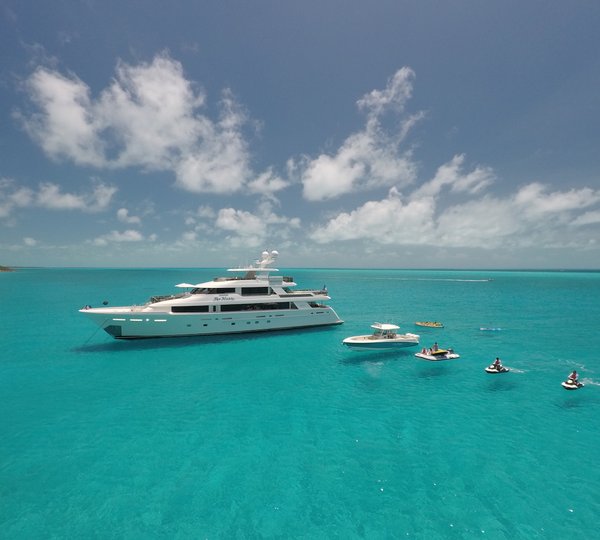
FAR NIENTE | From US$ 125,000/wk
Charterworld news.
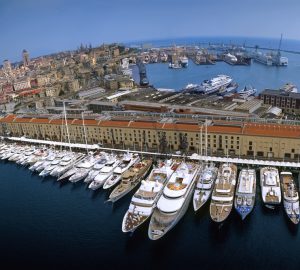
Looking ahead to the 2024 MYBA Charter ...
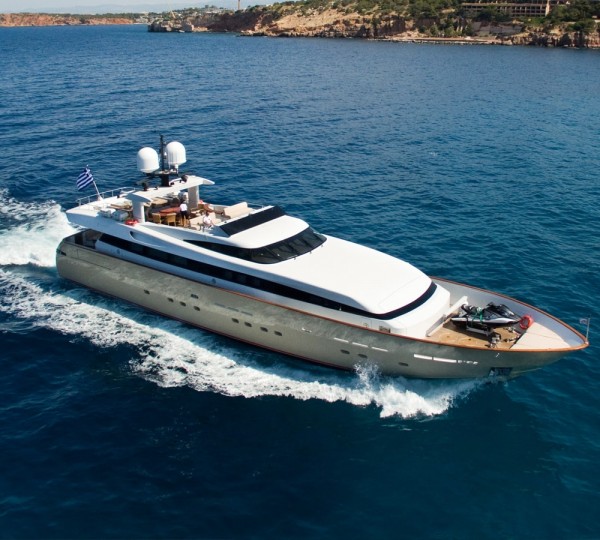

LOANA | From EUR€ 73,470/wk Special
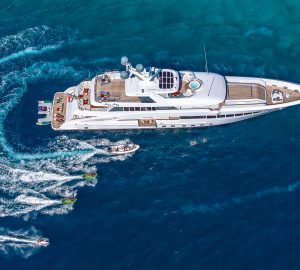
A tempting choice of luxury charter ...
- Inspirational Yacht Charter Articles >
- The Top 10 of Luxury Yacht Charters >
- The top ten largest catamarans for charter
Both experienced yachting enthusiasts and those new to the world of yacht charters choose to holiday and hold events aboard luxury catamarans for their unique advantages over monohulled vessels, and these 10 largest luxury catamarans available for charter are amongst the best available today. These impeccably maintained catamarans provide greater stability while cruising and at anchor, and the wider beam creates more space on board for hosting dockside events and revelling in the outdoor lifestyle wherever you travel. Of note are the huge cockpits that are weather protected, spacious foredecks with trampolines, and most large catamarans also have a flybridge for sunbathing and alfresco dining.
Catamarans are also generally considered to be faster than monohulls, and can often enter shallower bays to find hidden gems thanks to their low draft. A final catamaran benefit is twin engines to match the twin hulls, increasing safety and manoeuvrability while travelling between isles.
HEMISPHERE - 44.20m (145')
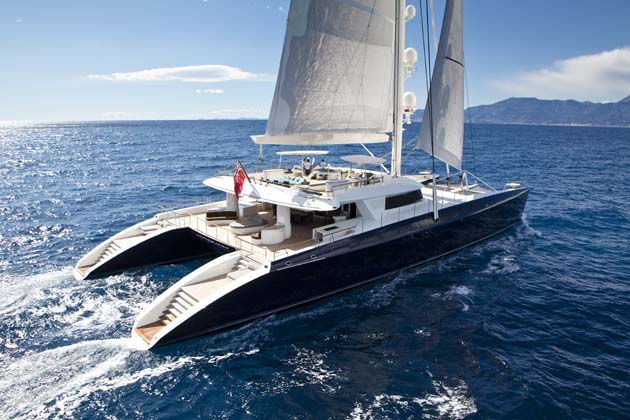
Since her launch in 2011 luxury catamaran HEMISPHERE has remained one of the largest catamarans in the world as well as the largest currently available on the charter market. She won Interior Layout Award: Sailing Yachts and Interior Design Award: Sailing Yachts at the Showboats Design Awards 2012 where she was also a finalist in other categories for her exterior design and on board amenities.
There are two dive instructors aboard this PADI Certified Dive Centre and the wide variety of water toys will satisfy adrenaline seekers as well as guests look to unwind in the water or on deck in peace. Earthen tones decorate the interior, where there are numerous seating areas for small groups, and the outdoor deck spaces offer a plethora or sunbathing options in addition to a flybridge Jacuzzi.
DOUCE FRANCE - 42.20m (138' 5")
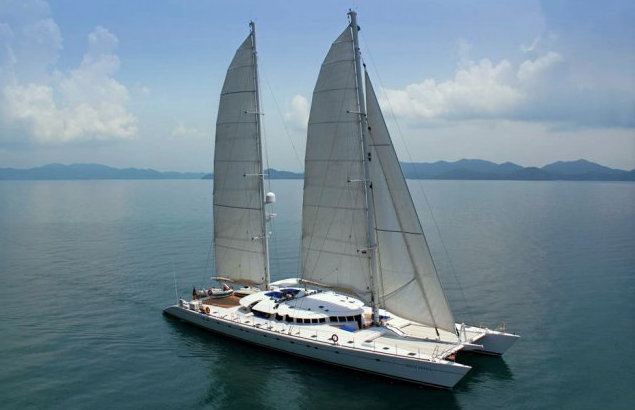
Built in 1998 by Alumarine and last refitted in 2015, DOUCE FRANCE provides late 20th Century style with classic wooden panelling and understated furnishings that create a warm and inviting atmosphere. On board there is a wine cellar with a 250 bottle capacity and an extensive collection of water toys including sail boats, sea kayaks, wind surfers and Scuba diving equipment, giving guests the opportunity to earn a recognised diving licence during their stay.
S/Y DOUCE FRANCE can sail at a constant 22 knots in 28 knots of breeze using her 528.8m2/5,692ft2 fore and aft sail area, and regularly achieves 15 knots in 20 knots of wind, making good time from island to island in charter grounds such as the Saronic Islands.
THE BEAST - 39.5m/129.7ft
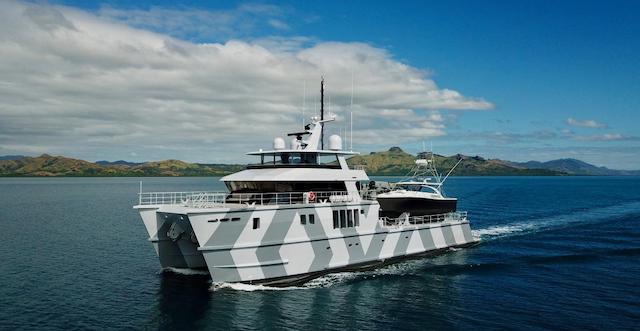
Motor catamaran THE BEAST is unusual on this list not only for her lack of sails but also because she is designed for expeditions. She was built in New Zealand and launched in 2019 by Profab Engineering with naval architecture by LOMOcean and deep, moody interiors by Oceania Interiors. Floor to ceiling windows let an abundance of natural light filter through to highlight the textures, and vibrant accents of colour can be found in the surrounding artwork. The main deck aft is used for storing the large water toys, including a custom-built sports fisher and an amphibious RIB. On the flybridge there is a Teppanyaki bar where guests can watch their dinner and dessert being prepared before them in incredible skill and showmanship.
CHE - 34.72m (113' 11")
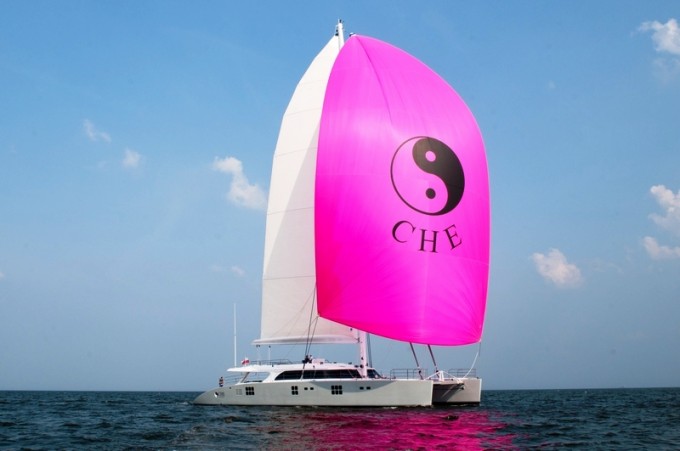
Sunreef catamaran CHE from 2010 was the shipyard's second custom-built superyacht. She has a voluminous 12.8m/42ft beam that results in a large interior salon, beautifully decorated in warm wooden panelling contrasted by vibrant furnishings in turquoise. The accommodation sleeps a maximum of eight guests in four en-suite cabins, and those on board have at their disposal a sizable cockpit filled with sofas, sunbeds and alfresco dining options shaded by the hard top. On the flybridge there is a sun-exposed sunbathing space and an alfresco dining area soaked in sunshine
QUARANTA - 34.10m (111' 11")
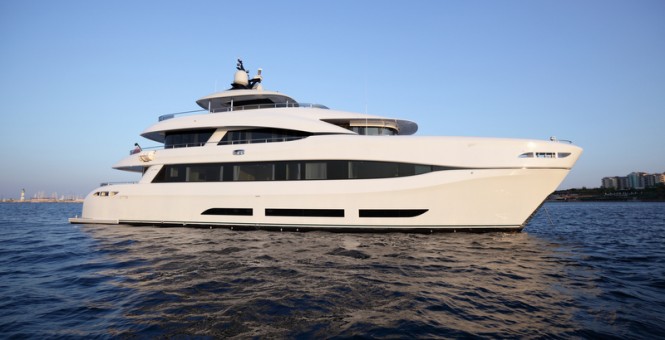
Motor catamaran QUARANTA from Curvelle - Logos in Turkey was built in 2013 was built in carbon composite and powered by a pair of Caterpillar C32 Acer diesel engines that allow her to achieve an excellent top speed of 25 knots and a fast cruising speed of 23 knots.
Sleeping up to 12 guests across six well-appointed and generously proportioned staterooms, M/Y QUARANTA treats guests to light and airy interiors as well as notable features such as the hydraulic swim platform that lifts to give guests and the tender easy access in and out of the sea. At deck level it adds to the area for lounging and entertaining with the tender docked safely out of sight between the two hulls. It can also be lowered to water level and become the beach club and with a touch of a button have two water cascades with spa bubbles from underneath.
BELLA VITA - 32m/105ft
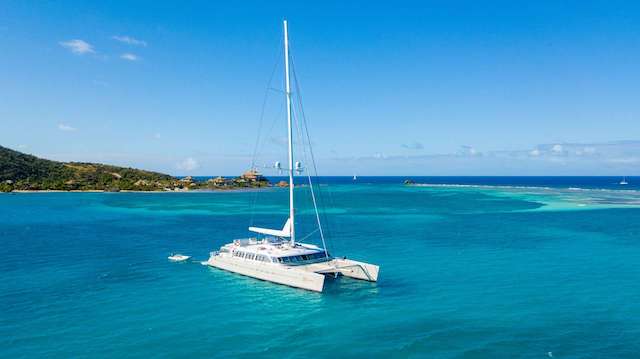
Guests looking for serenity and comfort will fall in love with luxury catamaran BELLA VITA , who is true to her name by offering calming, well-lit interiors suited to dining and lounging as a group or spending time on personal pursuits. She won Best New Refit at the World Superyacht Awards 2010 and has plenty of outdoor sunbathing areas, and there is a great selection of water toys for all ages and fitness levels to truly interact with your surroundings.
TIP TOP II - 31.7m/104ft
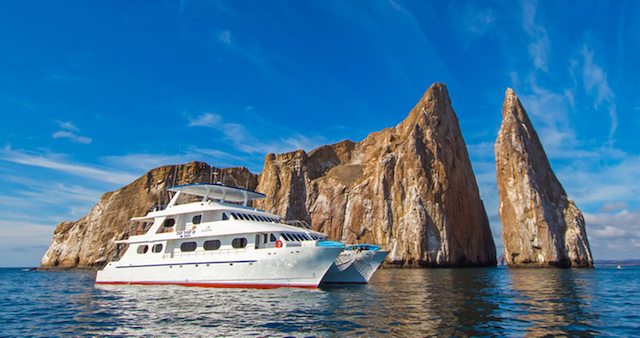
When you want to take a larger group for a cruise, options can seem few and far between - even aboard larger luxury yachts. M/Y TIP TOP II can host up to 16 guests overnight, who have a choice of 10 light and airy en-suite cabins. The large shared areas take advantage of the 12.2m/40ft beam and surround the rooms with windows for naturally lit interiors that are also fully air conditioned. The large salon and formal dining area will be filled with memories before you leave, and you'll never forget resting on the sundeck in the sunshine while enjoying a cocktail.
IPHARRA - 31.09m (102')
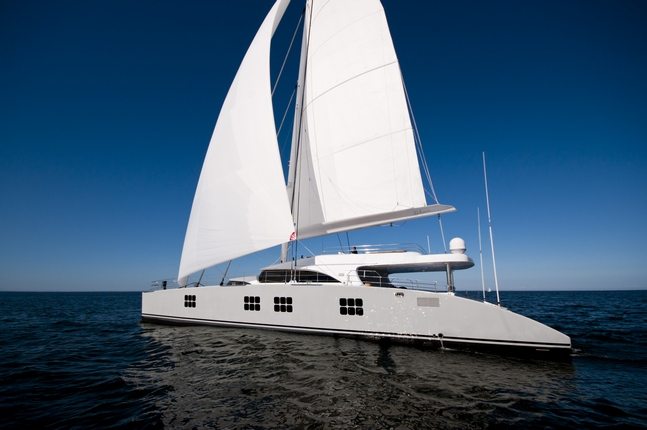
Luxury sailing yacht IPHARRA was launched in 2010 and is the first 102ft Sunreef multihull ever produced, in addition to currently holding the title of the world's second biggest sloop-rigged catamaran. She has comfortable accommodation for up to 12 guests in five spacious cabins, while the rest of the guest areas take advantage of her 12.8m/42ft beam for an extensive sun-drenched foredeck and sundeck while the shaded main deck aft also provides a generous outdoor living area.
HUTIANE - 31m/101.8ft
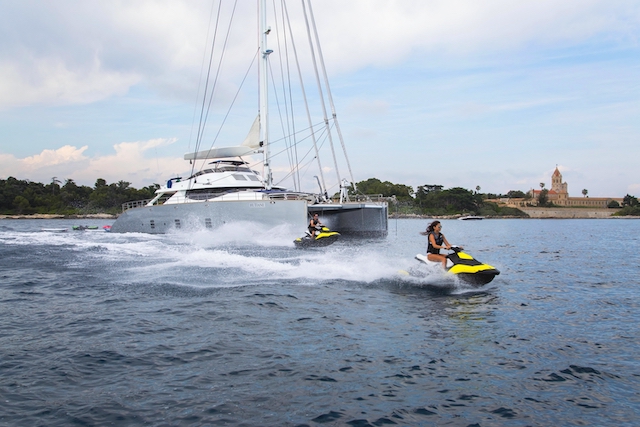
Superyacht HUTIANE from Cuneo Marine is highly desirable for her bright modern interiors where 'less is more' certainly means more space for guests within her 12.3m/40.3ft beam. Outside, the flybridge, foredeck and main deck aft create an abundance of space for hosting dockside events, and the latter area has a Jacuzzi along the stern for sweeping views of the scenery while resting. The accommodation sleeps up to 10 guests across four en-suite cabins, and there is a wide variety of water toys to suit all ages and interests.
MARTINA - 30.7m/100.9ft
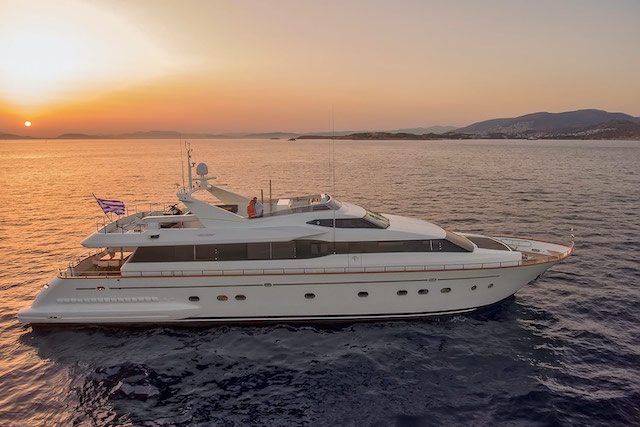
Luxury catamaran MARTINA is an excellent choice when you want to connect with your destination and loved ones: Her timeless cabins are well-proportioned and sleep 12 guests on five en-suite cabins, and make a desirable retreat at the end of an action-packed day exploring on land and in the water.
The sides of the main deck aft can be covered for use in less clement weather, while the sundeck and foredeck are ready to welcome guests for a day in the sunshine.
- The Top 10 of Luxury Yacht Charters
- The top 10 superyachts for charter
- The top 10 fastest superyachts for charter
- Top 10 Mediterranean Yacht Charter Destinations
- Top 10 Superyacht Charter Water Toys
- 10 Outrageous charter guest requests
- Celebrities' Top 20 Yachts Listed
- 16 Charter Yachts under $50,000
- The top 10 largest sailing yachts for charter
- The top 10 most expensive superyacht charters
Quick Enquiry
Royal falcon one | from eur€ 195,000/wk.
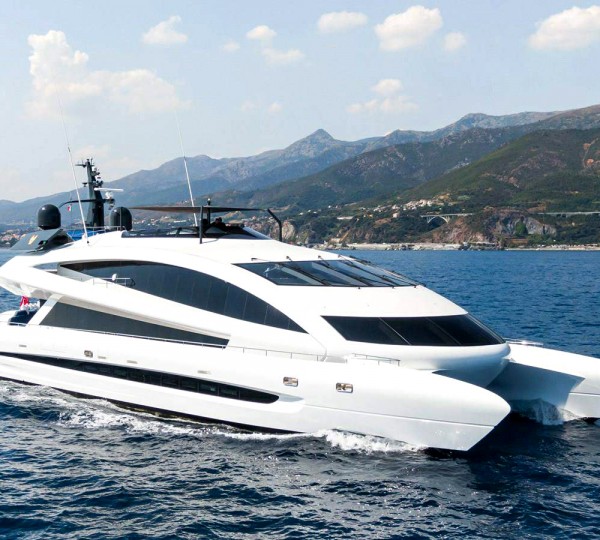
ISLAND PASSAGE | From NZ$ 176,000/wk
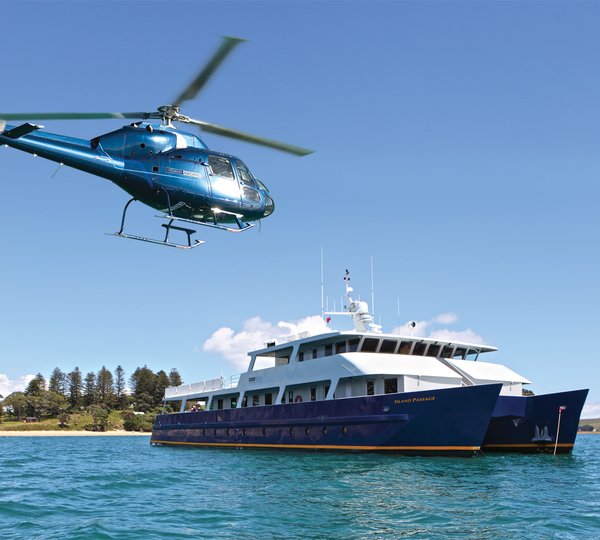
ELITE | From US$ 116,879/wk
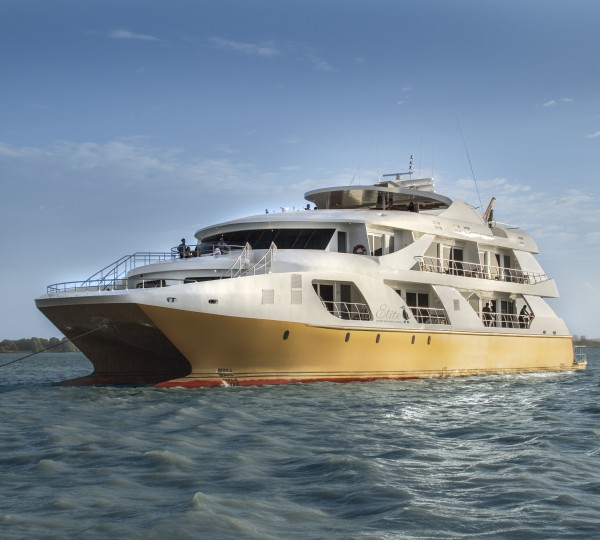
ENDEMIC | From US$ 116,879/wk
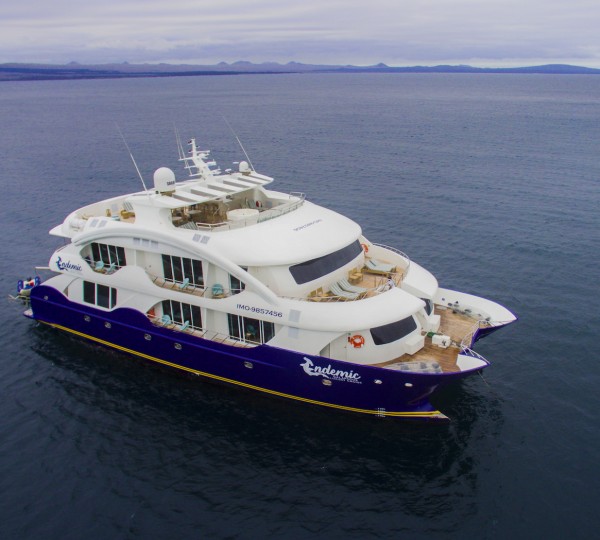
SPIRIT | From US$ 115,000/wk
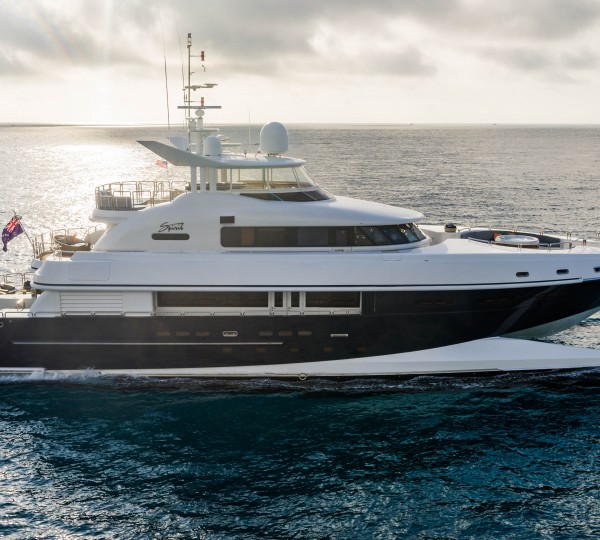
CORMORANT | From US$ 112,950/wk
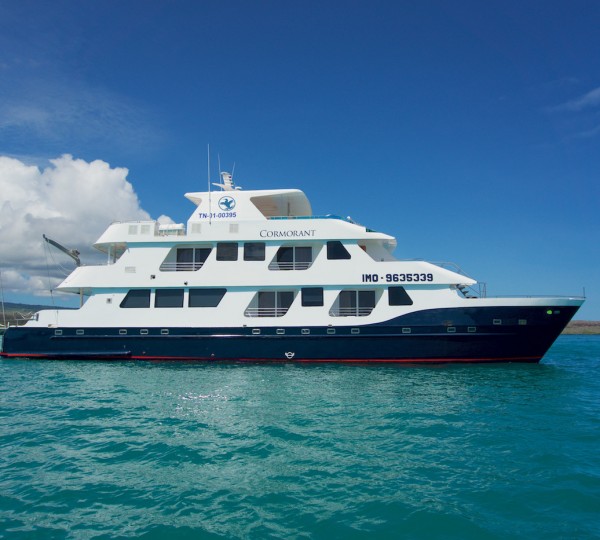
QUARANTA | From EUR€ 109,000/wk
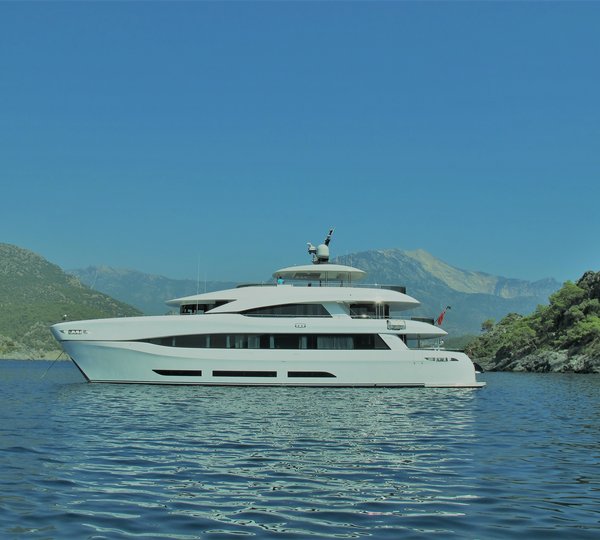
ENDLESS HORIZON | From US$ 100,000/wk
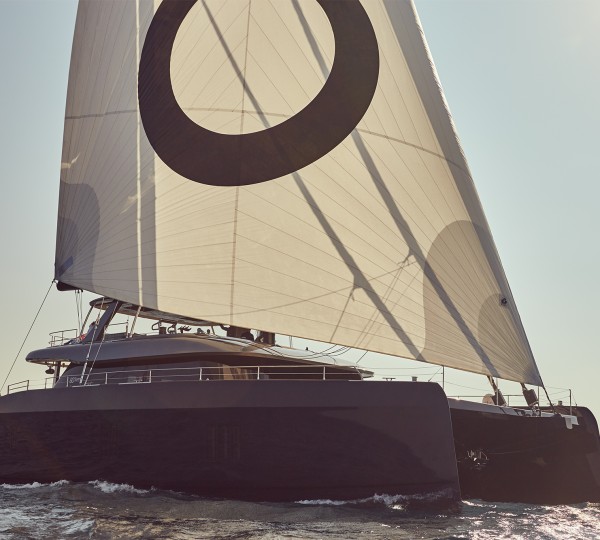
SOL | From US$ 100,000/wk
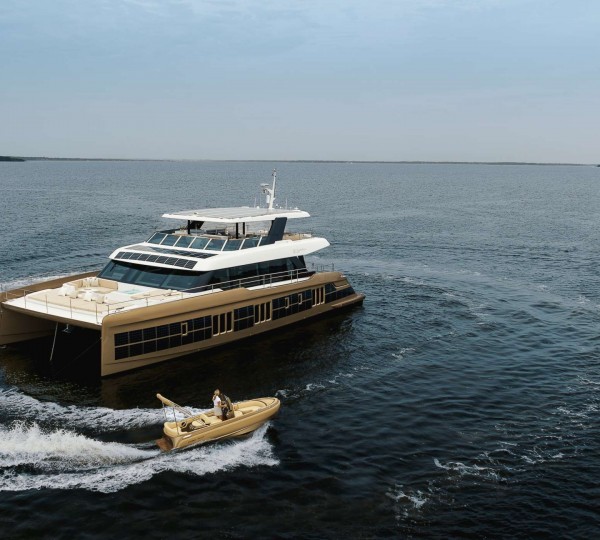
DOUCE FRANCE | From EUR€ 95,000/wk
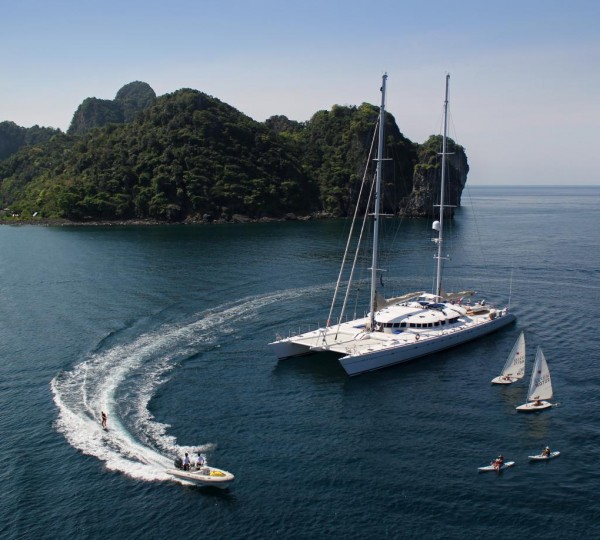
OHANA | From US$ 94,000/wk
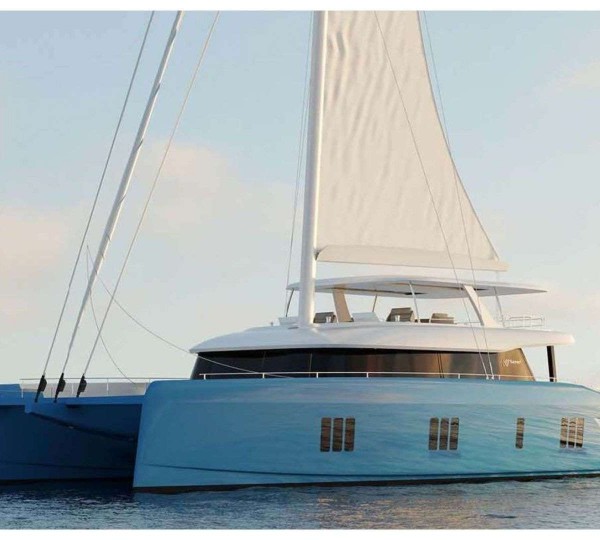
PRONTO | From US$ 90,000/wk
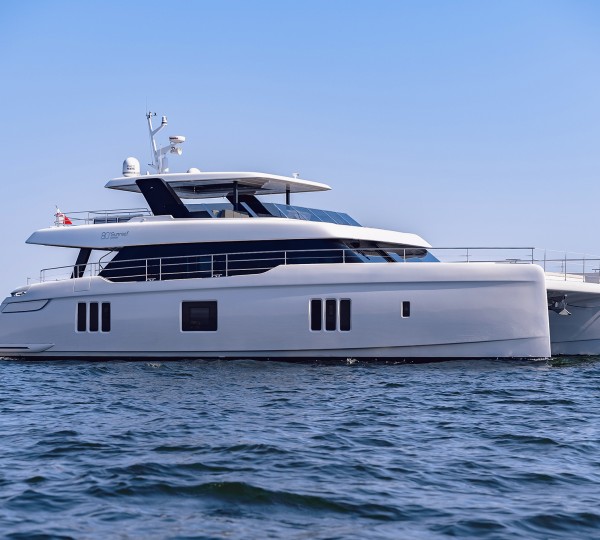
WindQuest | From US$ 85,000/wk
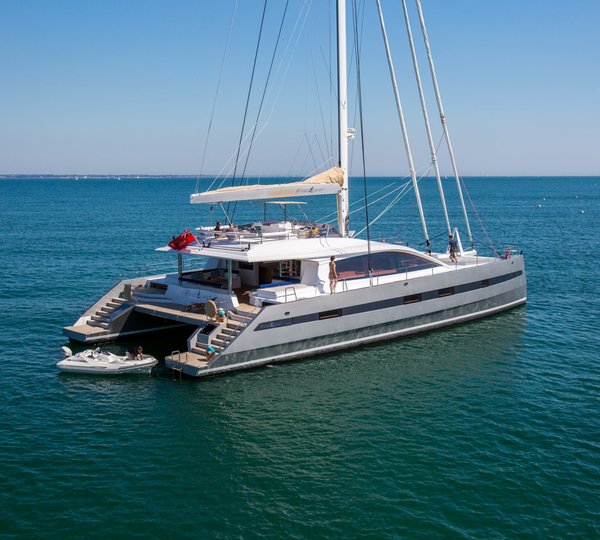
APOLLO 99 | From EUR€ 85,000/wk
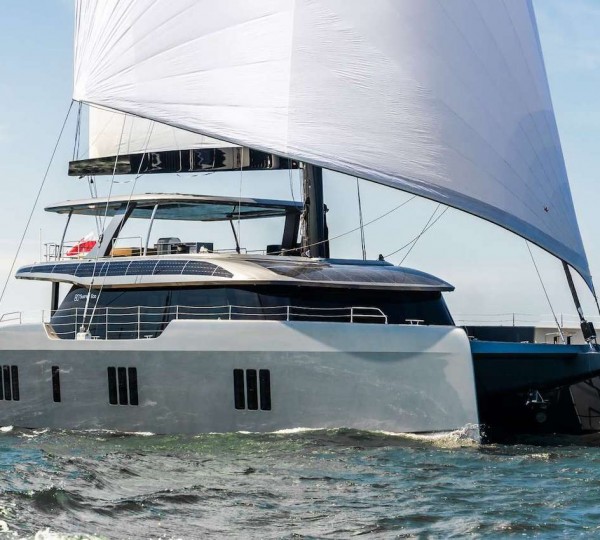
KUTSUNGA | From EUR€ 85,000/wk
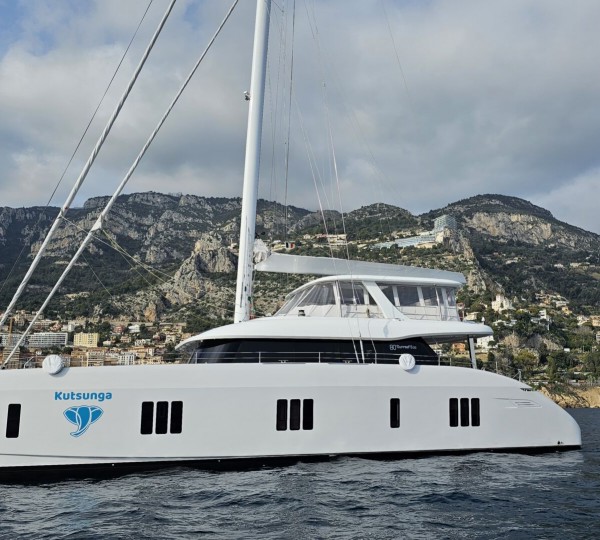
BOLDER WON | From US$ 84,000/wk
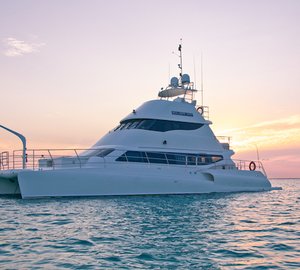
BUNDALONG | From US$ 80,000/wk
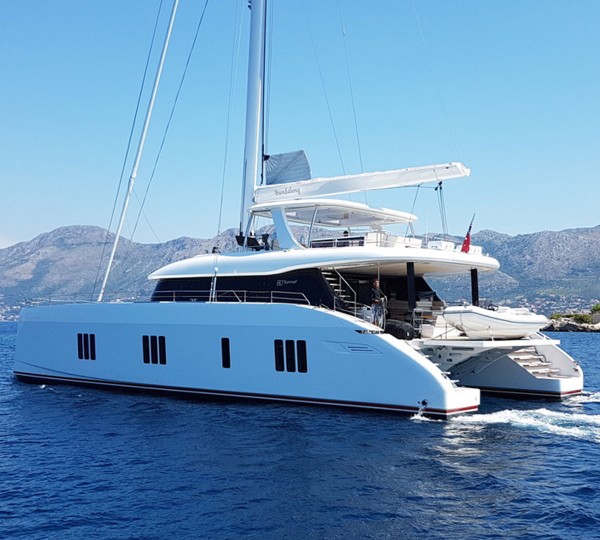
NALANI | From EUR€ 74,000/wk
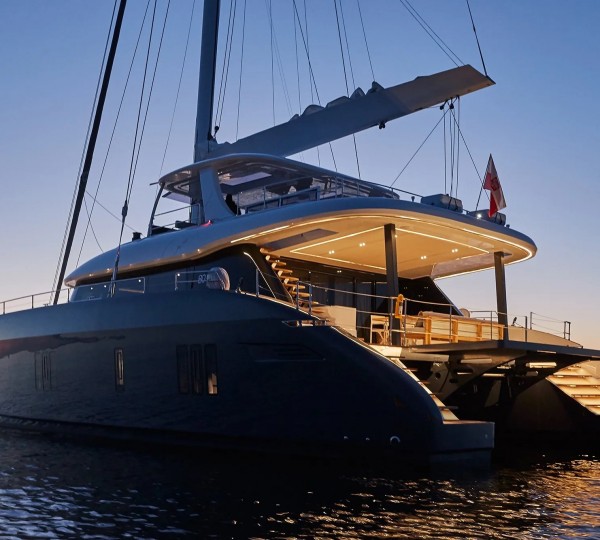
SYLENE | From US$ 72,000/wk
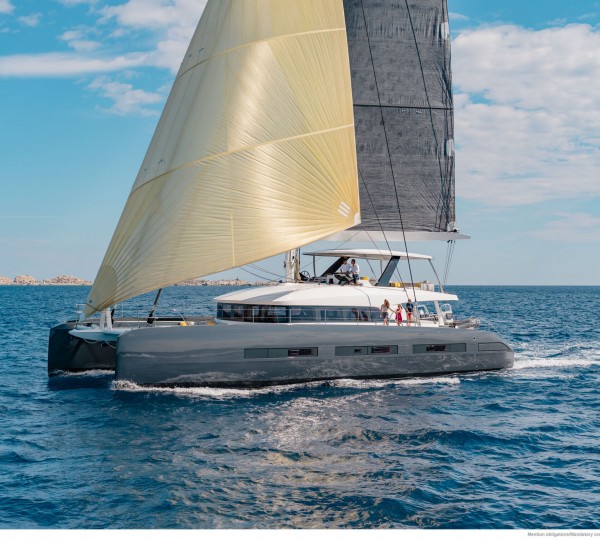
BELLA VITA | From US$ 70,000/wk
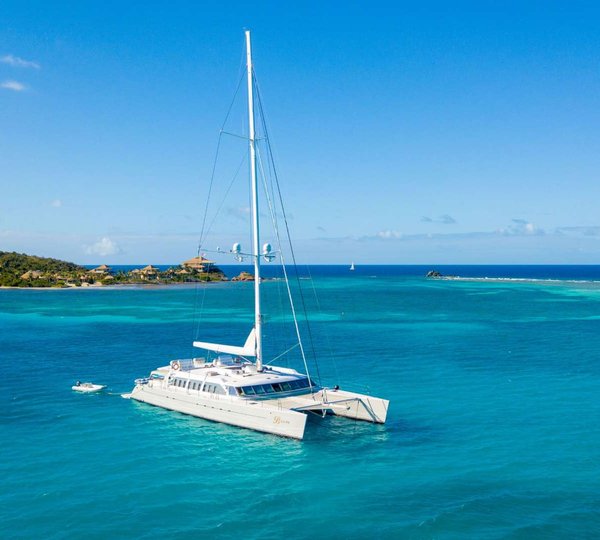
SERENISSIMA III | From EUR€ 70,000/wk
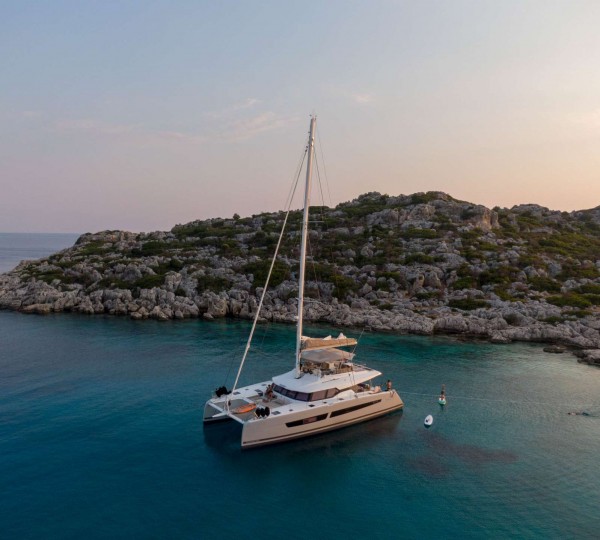
XMOTION | From EUR€ 70,000/wk
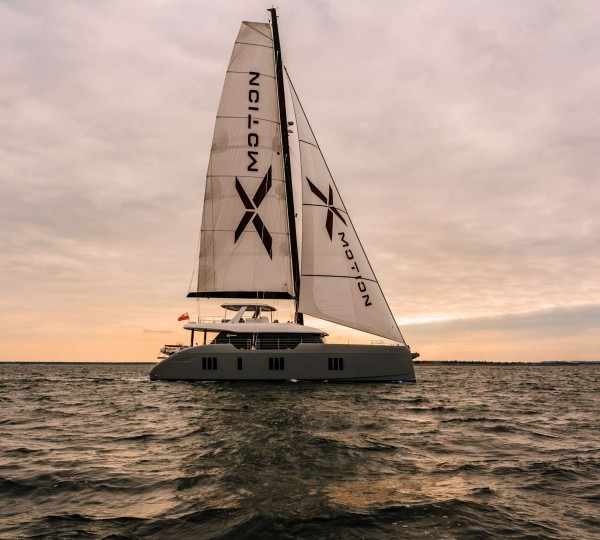
ONE PLANET | From EUR€ 68,000/wk
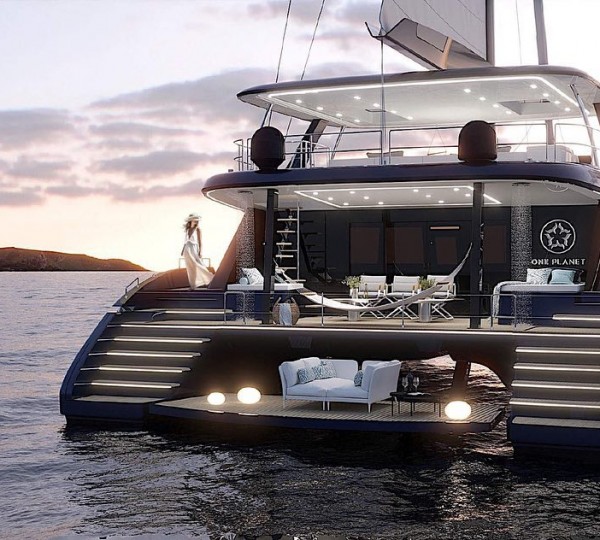
7X | From EUR€ 67,000/wk
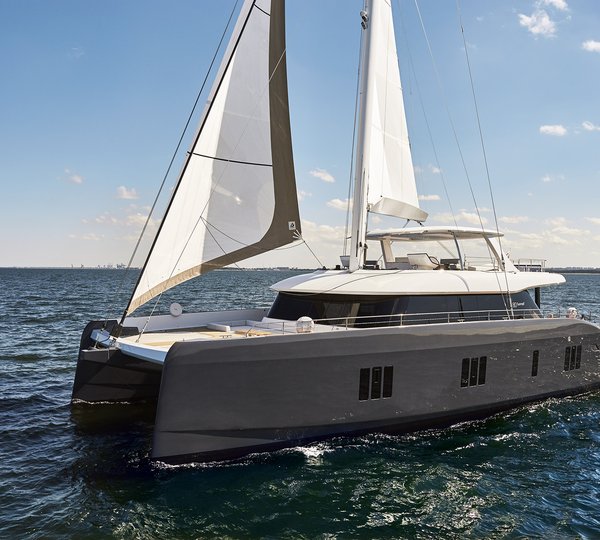
HUTIANE | From EUR€ 66,000/wk
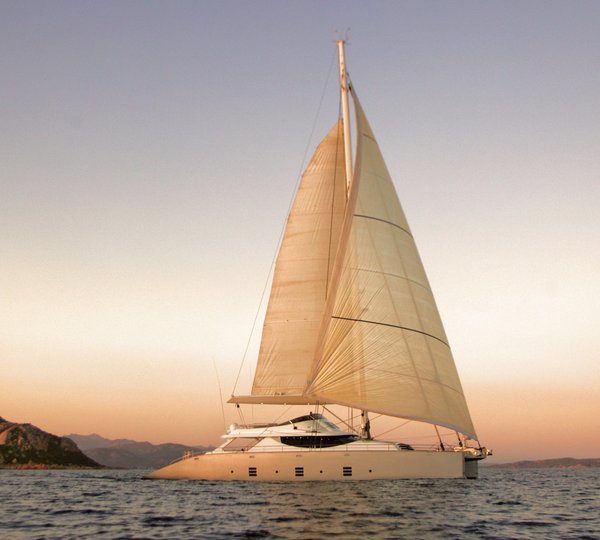
GINETTE | From EUR€ 65,000/wk
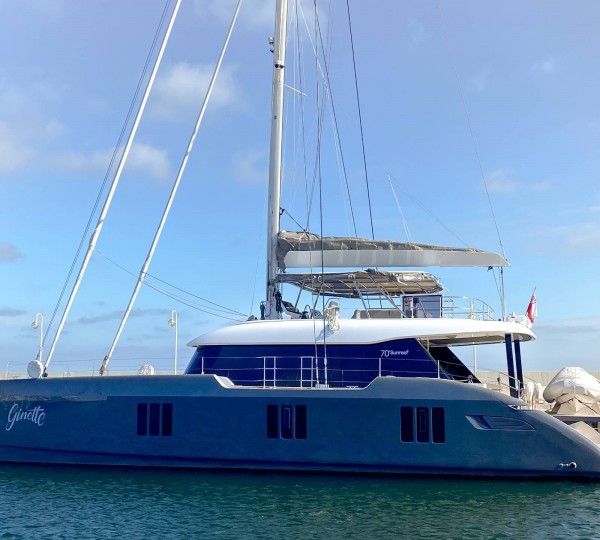
MANE Et NOCTE | From EUR€ 65,000/wk
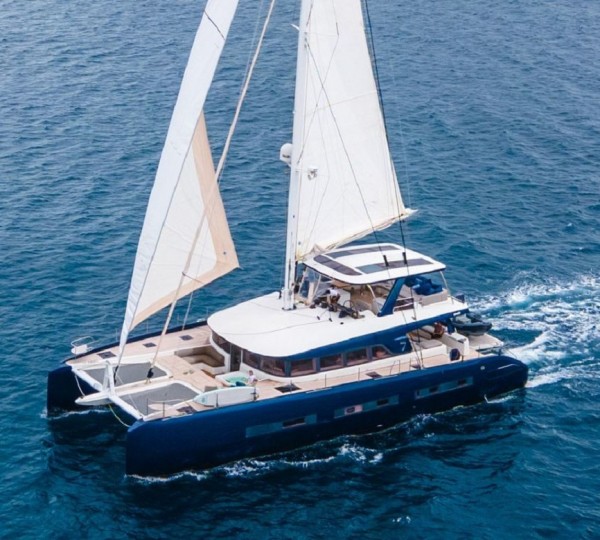
BABAC | From US$ 62,000/wk
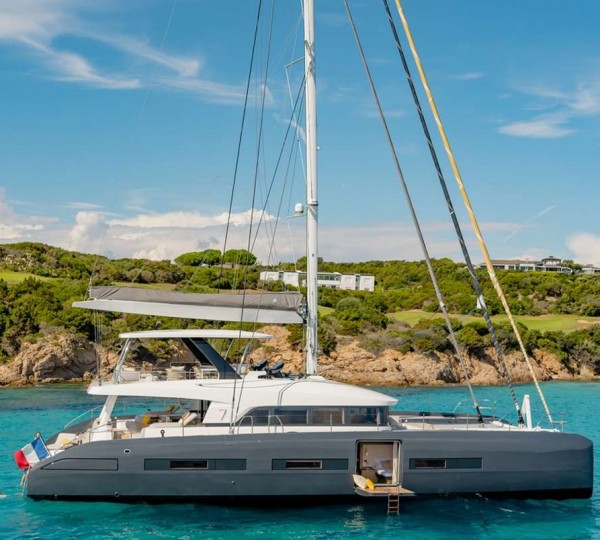
SEAGLASS | From US$ 62,000/wk
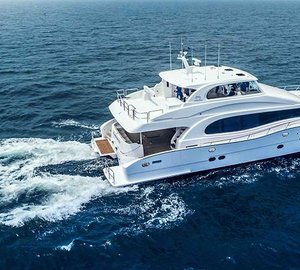
IPHARRA | From US$ 60,000/wk
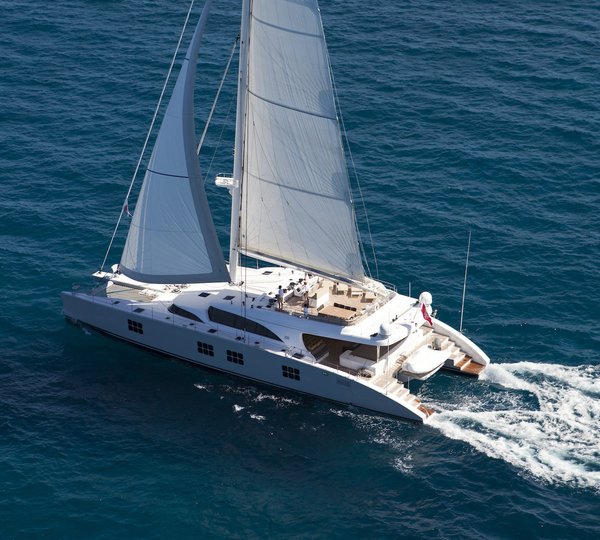
ROYAL RITA | From US$ 60,000/wk
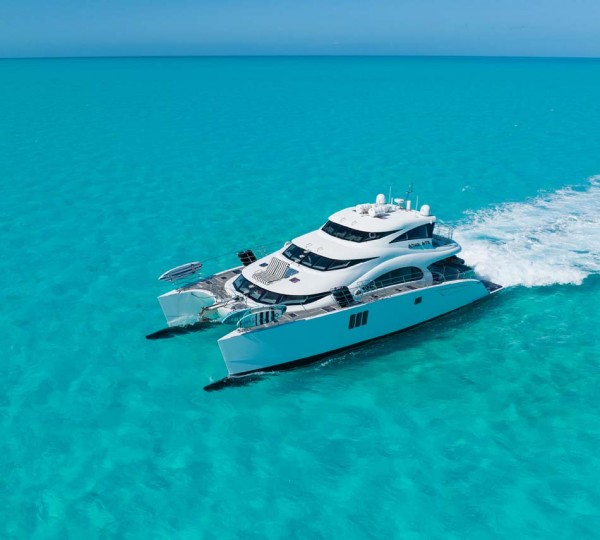
SAMELI | From EUR€ 59,000/wk
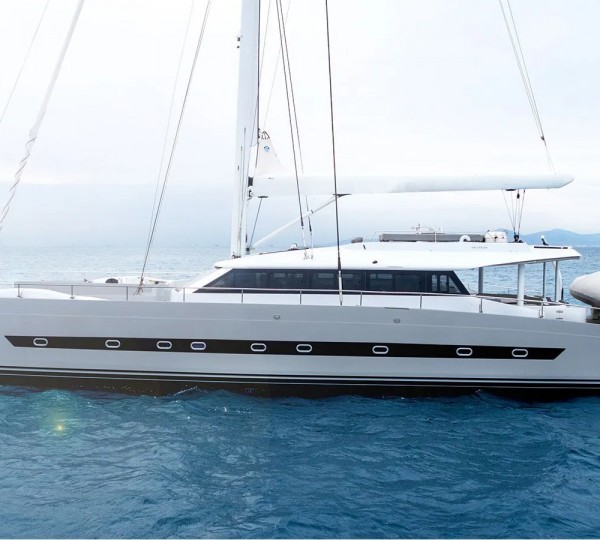
SASTA | From US$ 59,000/wk
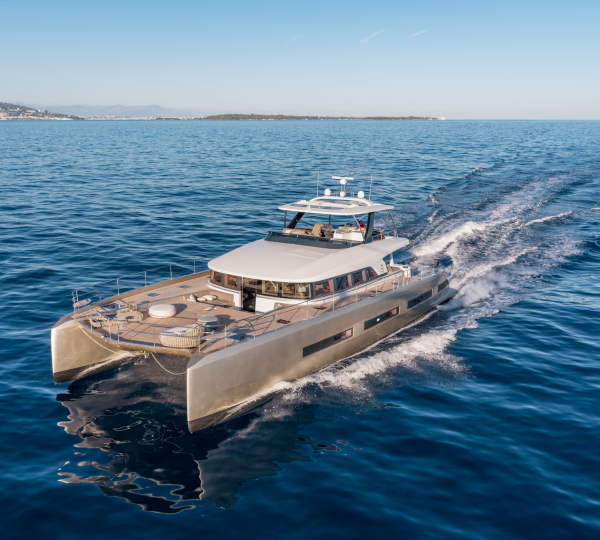
TELLSTAR | From US$ 58,000/wk
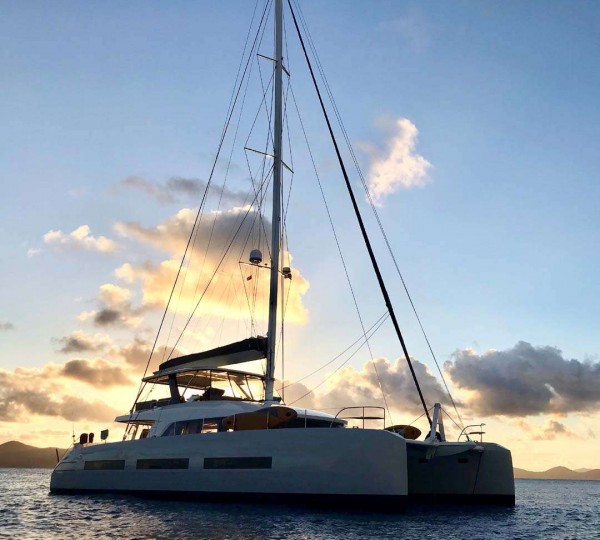
COLIBRI | From US$ 57,900/wk
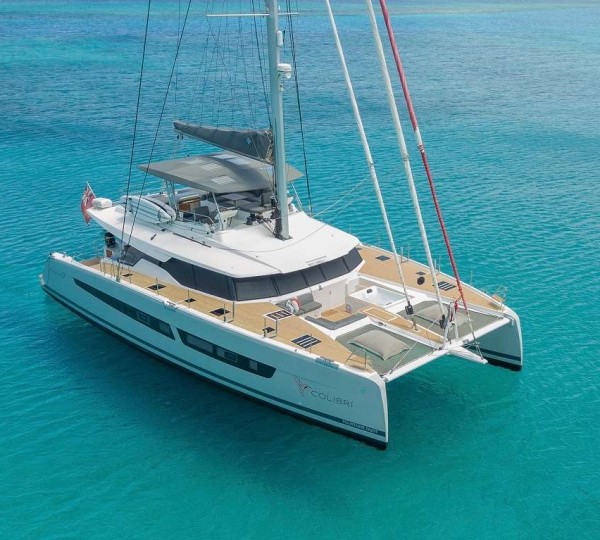
DIANA | From US$ 56,000/wk
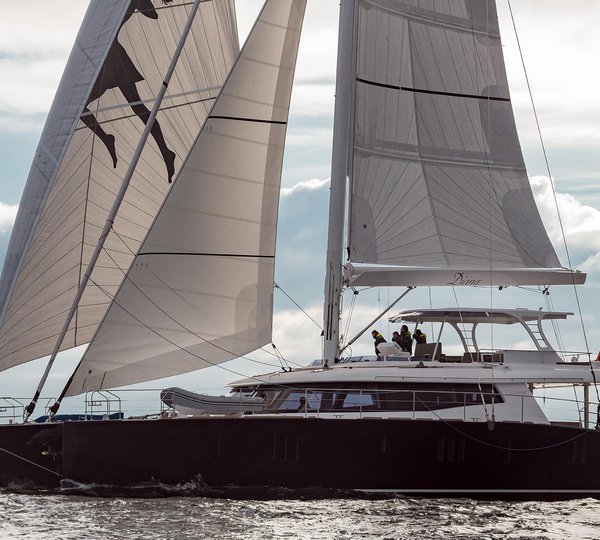
MY TY | From US$ 56,000/wk
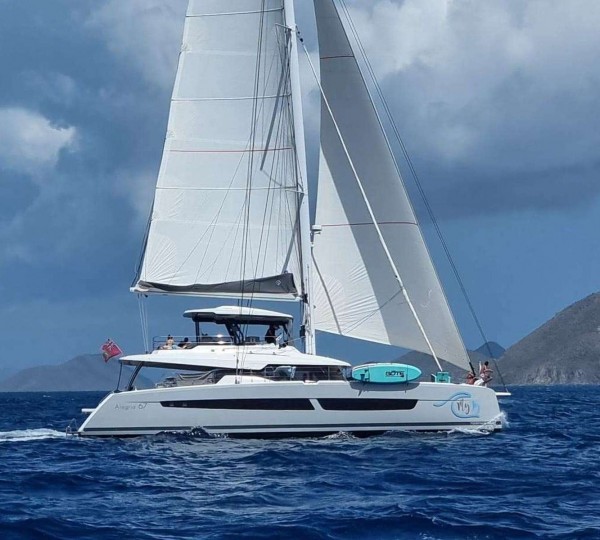
Motor Ultimate Lady | From US$ 55,000/wk
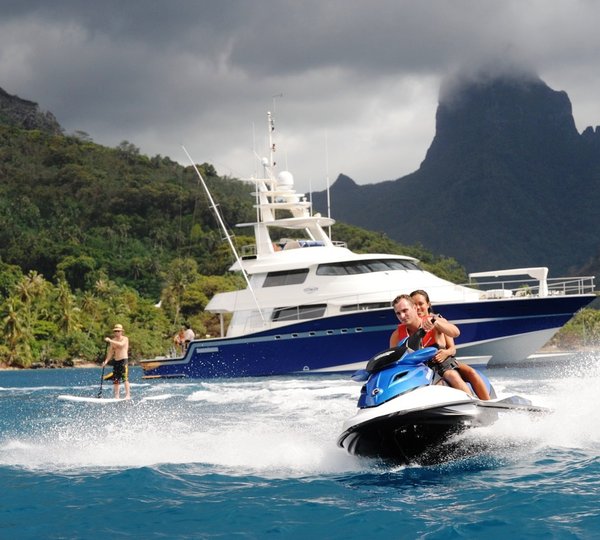
ULTIMATE LADY | From US$ 55,000/wk
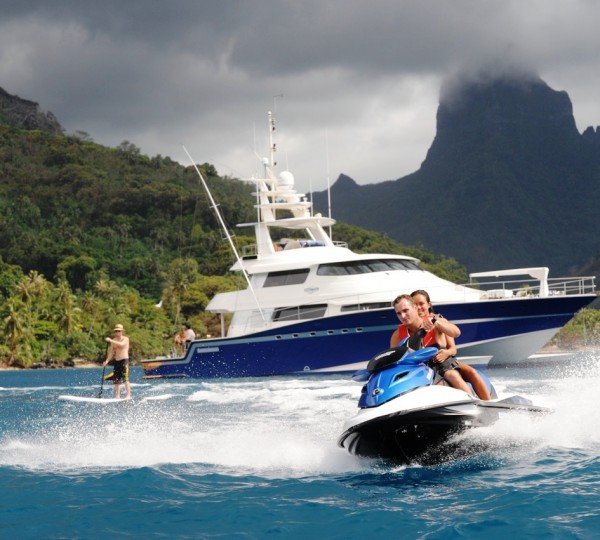
ALLURES | From EUR€ 55,000/wk
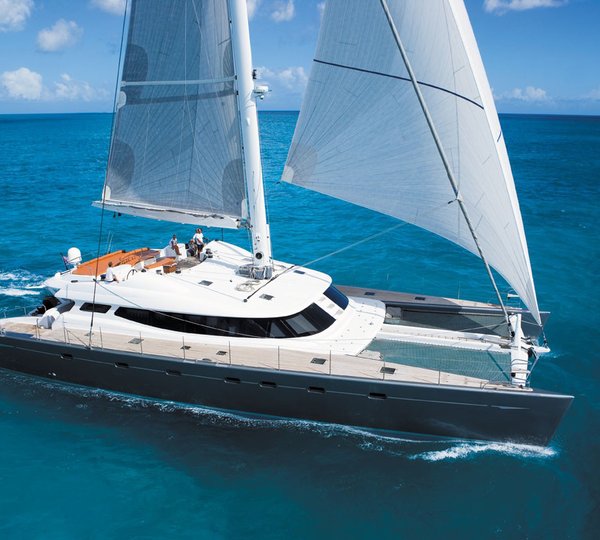
- Data and Options
CRUISER 34 - Interior
A lot of space for perfect comfort.
Whether 2 or 3 cabins, the CRUISER 34 offers many options and even more space.
With two cabins - and every comfort.
No compromises below deck. Even in the smaller 2‐cabin version of the CRUISER 34 you have all the amenities you need below deck for a cruise. A large, bright saloon – thanks to loads of natural light. A functional galley and a corner for the skipper to work and do planning. In short, a space with many well‐conceived options. So typically BAVARIA.

It’s like a home away from home – the huge bathroom of the 2‐cabin version.

Everything you need for navigating: the chart table corner.
Designed with passion for cooking with passion.
Meals are important, especially on longer trips. Sink, stove and refrigerator are tailored to meet the needs of a crew of six people. You can just as easily whip up some snacks as prepare a meal of several courses. Once again we have paid attention to detail – from the look of the solid wood surfaces to high‐quality equipment. There is therefore nothing standing in the way of convivial evenings with delicious food.

The classy galley has an L‐shape and a stainless steel sink.

Clever lighting concept for the salon.
Lovely days, equally lovely nights.
Up to six people can be accommodated on the BAVARIA CRUISER 34. Not one of them will lack for anything – even when it comes to bedtime. Aft there are two equally sizeable cabins, with another extremely comfortable cabin for the owner in the bow. Designed to be bright, with beautiful wood details – in short, three cabins that makes it easy to go to bed and hard not to lie in a little longer.

The bathroom includes a shower system.

View into one of the spacious aft cabins.
Ambience is a question of design.
You spend a lot of time on a yacht. That is why our engineers, designers and boat builders have also spent a lot of time trying to make it as comfortable and convenient as possible for you. Six people need space – and space they get, because the BAVARIA CRUISER 34 has, for example, storage space in every corner. Right in the middle there is a table around which everyone gathers to share the pleasure of letting a great day of sailing wind down to a wonderful end.

With the saloon table folded up, there is space for everybody and everything.

A lot of storage space in the salon.

- Download Brochure
- Contact Dealer
- Configure Now
- Virtual Tour
- Motorcycles
- Car of the Month
- Destinations
- Men’s Fashion
- Watch Collector
- Art & Collectibles
- Vacation Homes
- Celebrity Homes
- New Construction
- Home Design
- Electronics
- Fine Dining
- Baja Bay Club
- Costa Palmas
- Fairmont Doha
- Four Seasons Private Residences Dominican Republic at Tropicalia
- Reynolds Lake Oconee
- Scott Dunn Travel
- Wilson Audio
- 672 Wine Club
- Sports & Leisure
- Health & Wellness
- Best of the Best
- The Ultimate Gift Guide
10 Small Superyachts That Offer Supersized Interiors
These sub-100-footers combine broad beams with unconventional interiors to create the space of superyachts that are sometimes twice as long., howard walker, howard walker's most recent stories.
- This 1967 Shelby GT500 Has Been Reimagined to Perfection. Now It’s up for Grabs.
- One of Ferrari’s Earliest Formula 1 Cars Is Now Up for Grabs
- Aston Martin Unveils Its Fastest Vantage Road Car Ever. Here’s What We Know.
- Share This Article

For many yacht owners, the solution to finding more space aboard for friends and family is summed up by that immortal line by Chief Brody in Jaws : “You’re gonna need a bigger boat.”
Until now, bigger has typically meant longer. But that’s quickly changing as more and more builders are creating interior volume by going wider and taller. For disrupter builder Wally Yachts and its polarizing new Wallywhy 150—which refers to its internal volume rather than the boat’s length—the quirky design is said to deliver 50 percent more space than more traditional 78-footers.
Other builders like Princess have been in the game since 2021. Its X95 first appeared several years ago, effectively throwing down the gauntlet as a way forward for sub-100-foot yachts to supersize both interior and exterior volumes.
Since then, many other builders of small superyachts have jumped on board, with designs that typically have somewhat bloated profiles, far-forward main suites, and open transoms—features all designed to maximize space but minimize length.
Here are 10 new yachts 100 feet and under that are breaking the mold in an attempt to dominate the nautical space race.
wallywhy150

It’s no wonder that disrupter Italian builder Wally—now part of the Ferretti Group—calls its latest head-turner a “spaceship.” Claiming up to 50 percent more space than comparable 78-footers, the 150 (named after interior volume rather than length) has standout features like a main salon with over eight feet of headroom, and a beam of more than 22 feet. The pragmatic design includes a one-level main deck attached to an open rear cockpit that offers easy access to the water. Its most noteworthy feature is the rule-breaking, full-beam master suite tucked into the bow on the main deck. It has wraparound glass—stretching all the way around the bow—for panorama-like views from the main bedroom. Priced from about $6.7 million.
Lazzara UHV 87

Short for Ultra High Volume, this new Turkish-built pocket superyacht is a sistership to Lazzara’s UHV 100 and 125 models. The newest Lazzara boasts an impressive 2,153 square feet of interior space in its 87-foot length. Arguably, the boat is not pretty in a classic sense. The towering hull sides, blunt, plumb bow, and dark-tinted glass make it look more like a dinner cruiser than a mini-superyacht. But the interior space is astonishing, from the cavernous Sky Lounge, with its floor-to-ceiling windows, to the salon with a separate, chandelier-lit dining area and chef’s galley. With a fuel capacity of 3,000 gals, the twin 1,000 hp Volvo D13s deliver a top speed of 16 knots. The boat also has transatlantic range. Base price starts at about $10.9 million.
Sunseeker 100 Yacht

Movie nights under the stars should have a whole new appeal aboard UK builder Sunseeker’s brand-new 98-footer. Lie back on the yacht’s extra-wide foredeck sunpad and watch the latest blockbuster on a 140-inch screen with laser projection. Or, if you’re the lucky owner, stargaze from your private terrace tucked away in the bow, just steps from the full-beam main-deck master suite, with atrium-style glass sliding doors. One of the best innovations here is the wide, uninterrupted walkway around the entire top deck, which provides safe, easy access from the flybridge to the forward entertaining space. With its twin 2,600 hp V16 MTU diesels, top speed is an impressive 29 knots. Priced from about $10.5 million.
Azimut Grande 26M

For its brand-new Grande 26M compact superyacht, Italian builder Azimut has gone extra wide to create massive interior and exterior spaces. Spatial highlights include a full-width flybridge that’s almost 20 feet across and close to 40 feet long, and a foredeck entertaining area that seems more like an outdoor patio. The Alberto Mancini-styled go-fast cruiser is crammed with space-enhancing innovations, such as a teak-decked garage door that, at the touch of a button, hinges upwards to extend the rear cockpit by almost five feet. New ZF pod drives coupled to the yacht’s twin 1,650 hp MAN V12 diesels also save space. It is priced from about $6.2 million.
Princess X95

As we said during our 2021 tour of Britain’s Princess Yachts’ tri-deck X95 “When it comes to the polarizing, head-spinning design, there are no half-measures, no in-betweens. You either love it. Or loathe it.” But what those eye-popping lines hide is perhaps the most spacious 95-foot luxury cruiser in the category. Reckoned to be some 40 percent roomier than cruisers with the same length, the X95 has stretch-out accommodations for up to 10 in five cabins and living spaces that rival most apartments. The flybridge covers almost the entire length of the yacht. The 100 is also fast, with twin 1,990 hp MAN V12s delivering a top speed of 23 knots. Prices start at about $12 million.
Extra X96 Triplex

This broad-beamed 96-footer is from the Italian builder Extra Yachts, which is part of the Palumbo Superyachts Group. While it’s called the Triplex, there are actually four levels if you include the cozy upper sundeck with its outdoor kitchen, dining area, and oversized sunpads. The exterior comes courtesy of Italian designer Francesco Guida, while interiors are by Milan-based Hot Labs. Both teams have made the most of the yacht’s class-leading 25-foot beam. Notable features include a vast full-beam master on the main level and an upper salon dedicated entirely to dining, with a table for 10, an open chef’s galley, and an adjoining outdoor bar. Twin Volvo IPS1350s deliver a 16.5-knot top speed. Priced from $12 million.
Sunreef 100

This Sunreef power catamaran’s beam spans a staggering 44 feet, offering the kind of interior and exterior spaces you only get with superyachts twice the length. Every element of the yacht is XXL-size—from the massive hydraulic swim platform to the full-width flybridge that covers almost 1,000 square feet. Down in the salon is a huge 11-seat U-shaped bar that would delight any mixologist. The five staterooms in the twin hulls have space for 10. A pair of 1,300 hp MAN V8 diesels delivers a six-knot top speed. It is priced from about $15.3 million.
Absolute Navetta 75

In Italian, the word “navetta” translates to “little ship.” Which is a perfect description for Absolute’s new 75-foot fast cruiser. It’s an evolution of the strong-selling Navetta 73 but with nearly two feet of extra length. The yacht’s expansive interior volumes will remain the same, with features like a forward master stateroom on its own level that has a private entrance steps away from the main salon. The salon features floor-to-ceiling glass, with full views of the water, courtesy of open bulwarks. Twin 1,000 hp Volvo IPS1350 diesels deliver a top speed of 25 knots. Pricing starts at about $4 million.
Arcadia A96

Cross a spacious Miami high-rise penthouse with a Canyon Ranch spa and the result could be this new 96-foot superyacht from Italian builder Arcadia. Boasting a remarkable 4,300 square feet of total living space, there’s room for 12 guests and five crew. And the living spaces even expand, courtesy of fold-down terraces in the main salon and on the rear deck. But the yacht’s focus on wellness and healthy living sets it apart. That expansive, teak-decked foredeck, spanning over 500 square feet, is perfect for yoga sessions or meditation, while the cockpit and beach club offer another 1,000 square feet of social space. For extra peace and quiet at anchor, solar panels can provide up to nine hours of generator-free power.
Numarine 26XP Fast

Think of it as offering pace, with space. Turkish yard Numarine has been building its bold 85-foot 26XP explorer style mini-superyacht since 2018, but later this year, it will launch the U.S.-focused 26XP Fast. Instead of slow-churning 435 hp diesels and nine-knot cruising, it’s bolting-in a pair of mighty 1,800 hp MAN V12s and modifying the hull to deliver a top speed of 31 knots. What hasn’t changed is the XP’s cavernous interior and expensive deck space. Take the top-deck flybridge which, thanks to the yacht’s 21-foot beam and far-forward helm, spans over 700 square feet. That space will include a dining table for eight, a full outdoor kitchen, and more lounges than a Saint-Tropez beach bar. Prices start from $6.95 million.
Read More On:
- Azimut Yachts
- motoryachts
- Princess Yachts
More Marine

Open Space, Eco-Friendly Tech: What a Rising Class of Millennial Superyacht Owners Looks For

‘People Don’t Want to Be Inside’: How the Outdoors Became Yachtmakers’ Most Coveted Design Element

This New 220-Foot Custom Superyacht Is Topped With an Epic Jacuzzi

This Custom 112-Foot Trideck Superyacht Feels Bigger Than It Actually Is

Culinary Masters 2024
MAY 17 - 19 Join us for extraordinary meals from the nation’s brightest culinary minds.
Give the Gift of Luxury
Latest Galleries in Marine

The 10 Most-Exciting Yacht Debuts at the Palm Beach International Boat Show

‘Lady A’ Superyacht in Photos
More from our brands, france’s first move against ultra-fast fashion; new stretch textiles: sustainability week, carlyle group out as t-wolves purchase deadline nears, espn renews college football playoff rights through 2032, inks $7.8 billion extension deal, artist charles gaines says ica miami suggested removing and altering artworks in his exhibition, the best yoga mats for any practice, according to instructors.

Exploring the World’s 11 Largest Sailing Catamarans: Rankings and Key Facts
Table of Contents
Discover the top 11 largest sailing catamarans in the world, including rankings and key information about their size and capabilities. Learn about the feasibility of solo sailing, transatlantic crossings, and the risks of capsizing. Plus, explore reasons why catamarans may not be as popular as other types of vessels.”
Introduction: 11 largest sailing catamarans
This article explores the world of the largest sailing catamarans, ranking the top 11 largest vessels by size and providing key information about their capabilities. Before delving into the specifics, it’s important to understand what a catamaran is and why it’s such a popular type of vessel. A catamaran is a multihull boat that has two parallel hulls of equal size. This design provides numerous advantages, including increased speed, stability, and spaciousness compared to monohull boats. Catamarans are popular among sailors for their efficiency and comfort, making them an appealing option for cruising and racing alike.
Top 11 Largest Sailing Catamarans in the World:
The world’s largest sailing catamarans are truly awe-inspiring feats of engineering and design. Topping the list is the Black Pearl, a massive 106.7-meter vessel that boasts cutting-edge technology and luxury amenities. Other impressive entries on the list include the White Rabbit, the Hemisphere, and the Fujin. Each of these vessels represents the pinnacle of catamaran design and engineering, with unique features and capabilities that set them apart from the rest. Whether you’re interested in the latest in high-tech sailing or simply appreciate the beauty of these majestic vessels, the world’s largest sailing catamarans are sure to leave a lasting impression.
Can a Catamaran Cross the Atlantic?
Crossing the Atlantic in a catamaran is a major undertaking that requires careful planning and preparation. While it’s certainly possible to make the journey in a catamaran, there are several factors to consider before embarking on such a voyage. Catamarans have certain advantages over monohull boats for long-distance cruising, including greater speed and stability, as well as more living space. However, they also have some disadvantages, such as a higher center of gravity and a wider beam, which can make them more susceptible to rolling in rough seas. Ultimately, the decision to cross the Atlantic in a catamaran should be made based on careful consideration of these factors, as well as personal experience and skill level.
How Big of a Catamaran Can One Person Sail?
The size of a catamaran that one person can sail depends on several factors, including the individual’s experience level and the complexity of the vessel. In general, smaller catamarans with simpler rigging systems are easier for one person to handle, while larger catamarans with more complex systems require a crew. The key to successful single-handed sailing in a catamaran is having a thorough understanding of the vessel’s systems and being able to anticipate and respond to changing conditions quickly and effectively. With the right training and experience, however, it’s possible to sail a catamaran solo even up to a length of around 40-50 feet.
Do Large Catamarans Capsize?
While it’s true that catamarans have a reputation for being stable and safe, there is still a risk of capsizing, particularly with larger vessels. The risk of capsize depends on several factors, including the design and construction of the vessel, the conditions it’s operating in, and the skill of the crew. Generally speaking, catamarans are more stable than monohulls, thanks to their wide beam and low center of gravity. However, this stability can be compromised in extreme conditions, such as heavy seas or high winds. In order to minimize the risk of capsizing, it’s important to ensure that the vessel is well-maintained and that the crew has the appropriate level of training and experience.
Why Are Catamarans Not Popular?
There are several reasons why catamarans are not as popular as some other types of vessels, especially in certain regions of the world. One of the primary reasons is their high initial cost. Compared to monohull boats of the same length, catamarans are generally more expensive due to their larger size, greater stability, and more complex systems. This can make them less accessible for many people who are interested in sailing.
Another reason why catamarans are not as popular is that they require specialized skills and knowledge to operate. Catamarans have different handling characteristics than monohull boats, and they require a different approach to sailing. This means that sailors who are used to operating monohulls may find it difficult to adapt to catamarans, which can make them less appealing.
Finally, there are some misconceptions about catamarans that have contributed to their relative lack of popularity. For example, some people believe that catamarans are less seaworthy than monohull boats, or that they are less comfortable in heavy seas. However, in reality, catamarans can be just as seaworthy and comfortable as monohulls, and they offer a number of advantages in terms of speed, stability, and spaciousness. Ultimately, the decision to sail a catamaran or a monohull boat comes down to personal preference, experience, and the specific requirements of the sailing journey.
11 Largest Sailing Catamarans
- Black Pearl – 106.7 meters
- White Rabbit – 84 meters
- Hemisphere – 44.2 meters
- Fujin – 42.5 meters
- Douce France – 42.2 meters
- Hodor – 41.9 meters
- Galaxy of Happiness – 40.8 meters
- Lir – 39.6 meters
- Rapture – 34.1 meters
- WindQuest – 33.8 meters
- Alithia – 33.7 meters
It’s worth noting that these rankings can change over time as new, larger catamarans are built.
- Black Pearl – This sailing yacht is the largest in the world with a length of 106.7 meters. It features a unique design with three masts and a stunning black hull. Black Pearl is a luxurious vessel with a maximum speed of 30 knots and accommodations for up to 12 guests and 18 crew members.
- White Rabbit – With a length of 84 meters, White Rabbit is the second largest sailing catamaran in the world. This impressive yacht boasts an innovative design and advanced technology, including a hybrid propulsion system that allows for quiet and efficient sailing. White Rabbit can accommodate up to 10 guests in five luxurious cabins.
- Hemisphere – The Hemisphere is a 44.2-meter sailing catamaran that was launched in 2011. This stunning yacht has won multiple awards for its impressive design and luxurious features, including spacious interior and exterior living areas. Hemisphere can accommodate up to 12 guests in six cabins.
- Fujin – Fujin is a 42.5-meter sailing catamaran that was built in 2016. This high-performance yacht features a sleek design and can reach speeds of up to 20 knots. Fujin can accommodate up to 8 guests in four cabins and has a crew of 7.
- Douce France – Douce France is a 42.2-meter sailing catamaran that was launched in 1998. This elegant yacht has a classic design and has been recently refitted to include modern amenities and technology. Douce France can accommodate up to 12 guests in six cabins.
- Hodor – With a length of 41.9 meters, Hodor is a luxurious sailing catamaran that was launched in 2019. This impressive yacht features a modern design and advanced technology, including a carbon fiber mast and a hydraulic lifting platform. Hodor can accommodate up to 10 guests in five cabins.
- Galaxy of Happiness – Galaxy of Happiness is a 40.8-meter sailing catamaran that was built in 2020. This stunning yacht features a sleek design and advanced technology, including a hybrid propulsion system. Galaxy of Happiness can accommodate up to 12 guests in six cabins.
- Lir – Lir is a 39.6-meter sailing catamaran that was launched in 2014. This luxurious yacht features a classic design and modern amenities, including a Jacuzzi and a gym. Lir can accommodate up to 10 guests in five cabins.
- Rapture – Rapture is a 34.1-meter sailing catamaran that was launched in 2007. This elegant yacht features a classic design and luxurious accommodations, including a spacious master suite and four guest cabins. Rapture can accommodate up to 8 guests and has a crew of 5.
- WindQuest – With a length of 33.8 meters, WindQuest is a high-performance sailing catamaran that was built in 2014. This sleek yacht features a carbon fiber mast and can reach speeds of up to 24 knots. WindQuest can accommodate up to 8 guests in four cabins and has a crew of 4.
- Alithia – Alithia is a 33.7-meter sailing catamaran that was launched in 2002. This elegant yacht features a classic design and luxurious accommodations, including a spacious salon and dining area. Alithia can accommodate up to 8 guests in four cabins and has a crew of 4.
Leave a Comment Cancel Reply
Your email address will not be published. Required fields are marked *
Save my name, email, and website in this browser for the next time I comment.
Modern Catamaran Trends: Gimmicks or Valid Design Ideas?
The celebrity of the catamaran is not only swelling in racing, but also for cruising catamarans. At their conception, the atypical design enabled cats to sail faster and in shallower waters with less wind and crew than other sailing vessels. But for years the unorthodox design met with skepticism, leaving the catamaran with little commercial success. Additional challenges to adoption of early versions of cruising cats were the small, very cramped interiors by modern day standards, was heavy and lumbering handling abilities. Many sailors used to say they “were built like tanks and sailed like bricks”.
However, sailors soon realized that nothing could beat the comfort, speed, and safety of a well-designed modern catamaran as a cruising yacht. These vessels can achieve the highest speed for the smoothest ride and boast the most interior space and greatest safety of most ocean-going vessels. Sailors of all types are quickly overcoming earlier prejudices against the multihull design as contemporary design trends continue to produce catamarans that are faster, more exciting, more visually interesting, and safer than ever before.
The New Trends
Fun and interesting new trends in catamarans make sailing even more exciting than ever before. However, innovations are only useful if they contribute to good design, construction, and safety principles and it should fit your sailing purposes. Let’s take a look at some trends in modern cats:
1. Larger Catamarans for Fewer Crew
The new generation of catamaran, using modern composite construction and engineering can be built lighter, larger, and more spacious with very good power-to-weight characteristics. Currently, the trend leans increasingly towards larger catamarans. The average catamaran for a cruising couple now tends to be more in the 45ft to 50ft range. With composite engineering and installation of technologically advanced equipment, e.g., electric winches, furling systems, and reliable auto pilot, it is now possible for shorthanded crews to confidently sail larger boats with larger rigs. Technology has enabled modern catamarans’ bigger volume with more stiff and torsion resistant construction, without compromising stability and safety.
2. Inside Out: Convertible Main Living Areas
The design improvements of convertible living areas not only increases usable space and opens up the living areas, but also reduces interior maintenance and cleaning issues of traditional varnished wood surfaces. An open and convertible main living area with simple, hard-wearing composite materials reduces costs and time required to clean and maintain the boat. Big windows and opening vents allow light in and increase visibility. Gone are the submarine-like claustrophobic cabins typical of most traditional yachts. Owners’ cabins are luxurious, airy, and spacious serving as a very comfortable living space, rather than just a place to sleep.
3. Wave-Piercing or Reverse Bows
4. bulkhead helm stations or twin stern steering.
However, Gunboat moved the cockpit back under cover in its latest designs, just as Leopard introduced a forward cockpit with opening doors into the leisure-focused salon in their Leopard 44 and 48 models. The team at Catamaran Guru questions the suitability of this design feature for blue water catamarans that will encounter large seas, but nonetheless, it is a popular trend especially for the yacht charter market.
Ultimately for a cruising catamaran, our preference is a safe, protected helm station with good visibility and all the control lines leading back to the helm to create a static control station. Push-button controlled winches and windlass as well as the instruments and autopilot should be prominently located and protected within the cockpit.
5. The Flybridge Trend
Getting from the cockpit up to the flybridge and back down in bad weather can prove unsafe. To accommodate the flybridge, the goose neck and boom must be very high making stowing the main problematic. The higher gooseneck position also means that the center of effort is higher which impacts the vessel’s righting moment and is not as good as catamaran with a lower boom position and bulkhead steering. Just where the flybridge design will go is anybody’s guess but right now it has huge appeal for a lot of people.
6. Hydrofoils and Daggerboards
Because of design innovations like curved daggerboards and the hydrofoils, performance on cruising catamarans has improved tremendously but catamaran speed is relative. The most important benefit of speed of a multihull is the ability to outrun bad weather. Being able to average 2-3 knots faster on a catamaran than on a monohull, can help avoid bad weather. Many cruisers often tell us at Catamaran Guru, “I don’t care about performance,” but its not long before they understand that the heavy cruising cat is not quite as comfortable at sea – AND very slow. It makes no sense to buy a catamaran that will not sail at least 200nm per day when making passage.
7. Galley Up or Down
In modern catamarans, the most popular trend currently is galley up, making it a focal point of the main living and entertainment areas. When at sea, every meal comes from the galley, so live-aboards spend a lot of time in the galley and many cruising couples and families find that the separation of galley down in a hull is not ideal. When at sea, hauling hot food up and down the stairs is a safety hazard. Having the galley on the same level as the serving area and cockpit is less tiring and safer. Also, ventilation is better on the bridgedeck than down in the hulls, which makes cooking more comfortable, especially if you are prone to seasickness. The disadvantage of the galley up design is less privacy for the cook’s messes and it can significantly impact the size of the saloon seating area, especially on smaller cats.
Some manufacturers like the St Francis 50 and Antares 44 still trust in the galley down design. Galley down is often preferred for charter boats because it provides a private, self-contained cooking area with dedicated prep areas and utilizes space in the hull that might otherwise be less efficiently used. However, the most popular trend is galley up and it makes sense to most sailors, especially cruising couples and families.
More on our take for galleys up or down .
Is Speed and Interior Comfort Trumping Good Design?
- Catamaran stability is a function of beam and buoyancy, so light-weight strong construction, which translates into buoyancy, is a good thing. Typically cruising catamarans have a beam-to-length ratio of roughly 50%, meaning a 45′ long cat will be about 22′ wide. This will not only result in great interior space but also in a very stiff and efficient boat.
- The boat needs to have a robust COG (center of gravity) through good buoyancy fore and aft or waterline length to avoid “hobby horsing”, making for a smoother ride and better performance. Performance is a safety issue; it is always better to have the pace to get out of the way of bad weather. So some speed in reserve is great.
- Good bridgedeck clearance is important for seaworthiness and crew comfort at sea, by reducing slamming and better performance in rough conditions. However, a very high bridge deck clearance, together with, say 6.5ft of headroom in the saloon, the boat will be very high with a lot of windage. So there has to be a balance struck between bridge deck clearance and the height in the salon. A good rule of thumb for bridge deck clearance is to have good clearance is about 5% of overall length of the hull but 6% is excellent. A clearance of 4% is acceptable but on the low side.
Even in the age of computer modeling, yacht design remains a series of compromises and the use of a boat will dictate its visual design and performance characteristics to a large degree. A well-designed catamaran is ergonomic and pleasing to the eye. It should be sensible and safe, with performance that can get to a safe harbor when necessary. It all comes down to safety and comfort, especially in rough conditions.
Looking to buy a yacht? Contact us if you have any questions regarding catamarans for sale , Fractional Yacht Ownership or our Charter Management Programs .
Estelle Cockcroft
Join our community.
Get the latest on catamaran news, sailing events, buying and selling tips, community happenings, webinars & seminars, and much more!
2 thoughts on “Modern Catamaran Trends: Gimmicks or Valid Design Ideas?”
Good reading, informative and to the point. There is no reference to building standards and codes of practice. The Catamaran industry needs to “mature “ as more models and brands enter the market with the consumer paying for the downward spiral. Look forward to your next article.
Hi Gregor, you are right. There is no one uniform set of standards. Most countries have published guidelines, codes or laws that a boatbuilder must follow in order to sell a boat in that country. Some of the better known ones are USCG, ABYC, CE, AS/NZS and ABS. There is a lot of similarity between the different international regulatory bodies but just as many differences. Enforcement of these standards are sketchy. Labels are applied to boats i.e. “in compliance,” “certified” or “classified.” and it all means little if not enforced. In the US, it’s mostly up to the builder to voluntarily comply with the published guidance ( the all do since it’s in their interest). In the European Union, by law a boat has to be inspected, documented and certified. Australia and New Zealand publish their own set of rules. So it’s a miss mash of laws and rules and it’s hard for the consumer to pin down!
Leave a Comment Cancel Reply
Your email address will not be published. Required fields are marked *
Save my name, email, and website in this browser for the next time I comment.
Recent Posts
First-annual virgin islands boating exhibition (vibe).
VIBE – It’s a Destination Boat Show! Join us May 10 – 12 at
BALI Catamarans Unveils The New Bali 5.8 Flagship
CATANA GROUP launches its 14th BALI CATAMARAN model, the BALI 5.8, for the brand’s
Love Stories At Sea…because it’s valentine’s day
Because it’s Valentine’s day, we wanted to celebrate all the couples that we helped
Your Go-To Resource for all your Catamaran Needs!
Check out our brochure to learn about all we have to offer and why
For more than 30 years, we have been a part of the catamaran community and created Catamaran Guru™ to encourage and educate all the aspiring sailing out there. We understand the dream of traveling the world by catamaran and created a one-stop-shop to make that dream a reality for you.
- Stephen & Estelle
- Testimonials
Get Started
- Yacht Sales
- Used Yachts
- Charter Management
- Boat as Business Programs
- Seminars & Events
- LOG-IN/REGISTER
- 2021-2023 Train Rail Hackathon
- Sustainable Development Goals
- Infrastructure
- Administration
- Career Profiles
- Education & Training
- Enterprises
- Associations & Networks
- Individuals
- Education Providers Directory
Moscow Metro opens first section of Large Circle Line

What you can read next

Learn more about Australasian Railway Assocation courses
Adb to finance bangladesh railways fleet modernisation, loram to acquire georgetown rail equipment company, get in touch with us., join the community of rail talents.

Rail Talents is the platform for:
- Exchanging experiences, knowledge, success stories and management practices with international peers;
- Publishing and reading of articles, videos, blogs, presentations;
- Developing competencies and expertise;
- Engaging with a wide range stakeholders: railway professionals, industry partners, universities, etc.
PARTICIPATE
COPYRIGHT 2018 RAILWAY TALENTS
What are you looking for?

I am a future Rail Talent
Students, apprentices, professionals outside of the rail sector.

I am Rail Talent
Rail professionals,, consultants, trainers, researchers, experts..

I am looking for Rail Talent
Employers, project managers, employment agencies, job boards..
- POWER Plant ID
- POWER Events
- Connected Plant
- Distributed Energy
- International
- COVID-19 Coverage
- Carbon Capture
- Climate change
- Cybersecurity
- Distributed Power
- Electric Vehicles
- Energy Storage
- Environmental
- Instrumentation & Controls
- Legal & Regulatory
- Legislative
- Ocean/Marine
- Physical security
- Plant Design
- Power Demand
- Research and Development
- Supply Chains
- Tidal Power
- Waste to Energy
- About POWER
- Privacy Policy
- Diversity, Equity, Inclusion & Belonging
- Accessibility Statement
New modification of Russian VVER-440 fuel loaded at Paks NPP in Hungary
DECEMBER 14, 2020 — After the recent refueling at power unit 3 of the Hungarian Paks NPP, its VVER-440 reactor has been loaded with a batch of fresh fuel including 18 fuel bundles of the new modification. The new fuel will be introduced at all four operating power units of the Paks NPP, and the amount of new-modification bundles in each refueling will be increased gradually.
Development of the new VVER-440 fuel modification was completed in 2020 under the contract between TVEL JSC and MVM Paks NPP Ltd. Its introduction would optimize the hydro-uranium ratio in the reactor core, enabling to increase the efficiency of fuel usage and advance the economic performance of the power plant operation. All VVER-440 fuel modifications are manufactured at the Elemash Machine-Building Plant, a facility of TVEL Fuel Company in Elektrostal, Moscow Region.

“Introduction of a new fuel is an option to improve technical and economic performance of a nuclear power plant without substantial investment. We are actively engaged in development of new models and modifications of VVER-440 fuel for power plants in Europe. The projects of the new fuels for Loviisa NPP in Finland, Dukovany NPP in the Czech Republic, Mochovce and Bohunice NPPs in Slovakia, are currently at various stages of implementation. Despite the same reactor model, these projects are quite different technically and conceptually, since we take into account the individual needs and requirements of our customers,” commented Natalia Nikipelova, President of TVEL JSC.
For reference:
The project of development and validation of the new fuel has been accomplished with participation of a number of Russian nuclear industry enterprises, such as OKB Gidropress (a part of Rosatom machine-building division Atomenergomash), Bochvar Institute (material science research facility of TVEL Fuel Company), Elemash Machine-building plant and Kurchatov Institute national research center. At the site of OKB Gidropress research and experiment facility, the new fuel passed a range of hydraulic, longevity and vibration tests.
Paks NPP is the only functioning nuclear power plant in Hungary with total installed capacity 2000 MWe. It operates four similar units powered by VVER-440 reactors and commissioned one by one in 1982-1987. Currently, Paks NPP is the only VVER-440 plant in the world operating in extended 15-monthes fuel cycle. The power plant produces about 15 bln kWh annually, about a half of electric power generation in Hungary. In 2018, the project of increasing the duration of Paks NPP fuel cycle won the European competition Quality Innovation Award in the nomination “Innovations of large enterprises”. Russian engineers from TVEL JSC, Kurchatov Institute, OKB Gidropress, Bochvar Institute and Elemash Machine-building plant provided assistance to the Hungarian colleagues in accomplishment of the project.
TVEL Fuel Company of Rosatom incorporates enterprises for the fabrication of nuclear fuel, conversion and enrichment of uranium, production of gas centrifuges, as well as research and design organizations. It is the only supplier of nuclear fuel for Russian nuclear power plants. TVEL Fuel Company of Rosatom provides nuclear fuel for 73 power reactors in 13 countries worldwide, research reactors in eight countries, as well as transport reactors of the Russian nuclear fleet. Every sixth power reactor in the world operates on fuel manufactured by TVEL. www.tvel.ru

Russia’s BN800 fast reactor fully fuelled with mox
!{Model.Description}
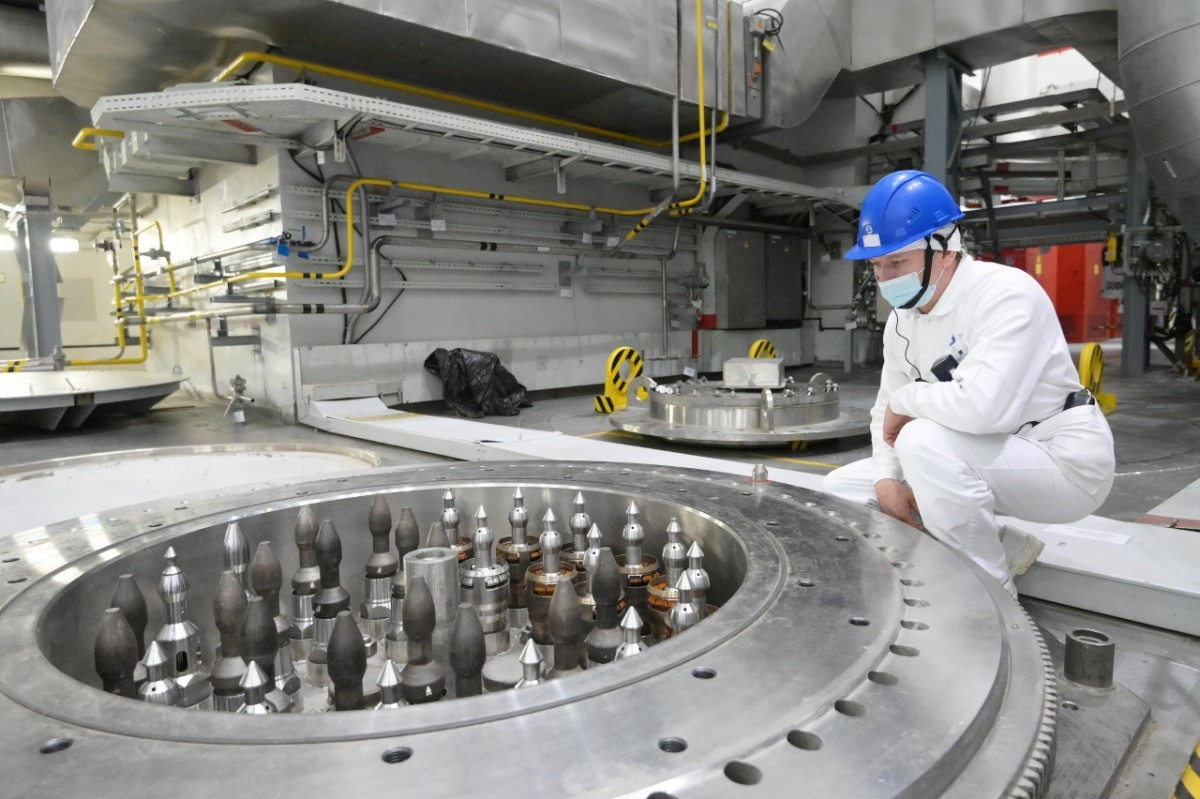
Beloyarsk 4 was connected to the grid and resumed electricity production after the completing its latest regular maintenance and refuelling outage. It was refuelled with mox fuel assemblies (FAs) produced at the Mining and Chemical Combine (MCC) in Zheleznogorsk, Krasnoyarsk Territory). Unlike the enriched uranium FAs traditionally used in NPPs, the raw materials for the production of mox fuel pellets includes plutonium oxide obtained during the processing of used fuel from conventional VVER reactors alongside depleted uranium oxide, obtained by defluorination of depleted uranium hexafluoride (DUHF – “tails" from enrichment production).
The first serial mox-FAs were loaded into the BN-800 core in January 2020. The first complete refuelling of the BN-800 with mox fuel took place in January 2021, and then, over the next two refuellings, all fuel assemblies were gradually replaced with innovative mox assemblies.
Other important work performed during the outage of unit 4 included overhaul of the main circulation pump with the replacement of the removable parts, maintenance and repair of pumps, heat exchangers, steam generators and a turbogenerator. Also, the operational quality control of metal and welded joints of pipelines was carried out as well as tests of the system for monitoring the tightness of shells using a metrological assembly.
“Today, Beloyarsk NPP is one of the flagships bringing the Russian nuclear industry closer to a new technological platform based on a closed nuclear fuel cycle,” said Beloyarsk NPP Director Ivan Sidorov. “The use of mox fuel will make it possible to increase the fuel base of the nuclear power industry tenfold. And most importantly, in the BN-800 reactor, after appropriate processing, used nuclear fuel from other NPPs can be recycled.”
Alexander Ugryumov, Senior Vice President for Scientific and Technical Activities at TVEL said completing conversion of BN-800 to mox fuel is a long-awaited event for the nuclear industry. “For the first time in the history of the Russian nuclear power industry, we will be able to operate a fast neutron reactor with a full load of uranium-plutonium fuel and a closed nuclear fuel cycle. This is exactly the milestone for which the BN-800 was originally designed, a unique nuclear power unit supported by automated fuel production at the Mining and Chemical Combine. Advanced technologies for recycling nuclear materials will significantly expand the raw material base of nuclear energy by processing irradiated fuel instead of storing it, and it will also reduce the amount of waste generated.”
Industrial fabrication of mox fuel began at the end of 2018 at the MCC. To create this unique production, broad industry cooperation was organised under the coordination and scientific leadership of TVEL, which also acts as the supplier of mox FAs for the Beloyarsk NPP. Initially, during the start-up of the BN-800 reactor, a hybrid core was installed, partly equipped with uranium fuel produced by Mashinostroitelny Zavod in Elektrostal (Moscow Region), and partly with experimental mox fuel assemblies manufactured at the Research Institute of Atomic Reactors in Dimitrovgrad, Ulyanovsk region.
Image: MOX fuel assemblies are loaded into the BN-800 fast reactor core at Beloyarsk NPP (courtesy of TVEL)
- Terms and conditions
- Privacy Policy
- Newsletter sign up
- Digital Edition
- Editorial Standards

- Vacation Rentals
- Restaurants
- Things to do
- Elektrostal Tourism
- Elektrostal Hotels
- Elektrostal Bed and Breakfast
- Flights to Elektrostal
- Elektrostal Restaurants
- Things to Do in Elektrostal
- Elektrostal Travel Forum
- Elektrostal Photos
- Elektrostal Map
- All Elektrostal Hotels
- Elektrostal Hotel Deals
- Elektrostal Hostels
- Elektrostal Business Hotels
- Elektrostal Family Hotels
- Elektrostal Spa Resorts
- 3-stars Hotels in Elektrostal
- Elektrostal Hotels with Banquet hall
- Elektrostal Hotels with Game room
- Hotels near Electrostal History and Art Museum
- Hotels near Park of Culture and Leisure
- Hotels near Statue of Lenin
- Hotels near Museum and Exhibition Center
- Hotels near Museum of Labor Glory
- Hotels near (ZIA) Zhukovsky International Airport
- Hotels near (VKO) Vnukovo Airport
- Hotels near (DME) Domodedovo Airport
- Disney's Caribbean Beach Resort
- Hotel Riu Republica
- Excalibur Hotel & Casino
- Hyatt Ziva Cap Cana
- The Mirage Hotel & Casino
- Wyndham Alltra Cancun
- Dreams Macao Beach Punta Cana
- The Westin Reserva Conchal, an All-Inclusive Golf Resort & Spa
- Barcelo Bavaro Palace All Inclusive Resort
- Hilton Cancun, an All-Inclusive Resort
- Dreams Jade Resort & Spa
- Disney's Coronado Springs Resort
- Luxor Hotel & Casino
- Grand Hyatt Baha Mar
- Westgate Las Vegas Resort & Casino
- Popular All-Inclusive Resorts
- Popular Beach Resorts
- Popular Family Resorts
- Popular All-Inclusive Hotels
- Popular Hotels With Waterparks
- Popular Honeymoon Resorts
- Popular Luxury Resorts
- Popular All-Inclusive Family Resorts
- Popular Golf Resorts
- Popular Spa Resorts
- Popular Cheap Resorts
- All Elektrostal Restaurants
- Restaurants near Restaurant Globus
- Cafés in Elektrostal
- Chinese Restaurants in Elektrostal
- European Restaurants for Families in Elektrostal
- European Restaurants for Large Groups in Elektrostal
- European Restaurants for Lunch in Elektrostal
- Fast Food Restaurants in Elektrostal
- French Restaurants in Elektrostal
- Italian Restaurants in Elektrostal
- Japanese Restaurants in Elektrostal
- Pizza in Elektrostal
- Russian Restaurants in Elektrostal
- Seafood Restaurants in Elektrostal
- Vegetarian Restaurants in Elektrostal
- GreenLeaders
- Elektrostal
- Things to Do
- Travel Stories
- Rental Cars
- Add a Place
- Travel Forum
- Travelers' Choice
- Help Center
- Europe
- Russia
- Central Russia
- Moscow Oblast
- Elektrostal
- Elektrostal Restaurants
Restaurant Globus
Ratings and reviews, location and contact, restaurant globus, elektrostal - restaurant reviews & photos - tripadvisor.

IMAGES
VIDEO
COMMENTS
A catamaran typically has a spacious interior with two or three cabins, a galley, and a dining area. Depending on the size of the catamaran, there may also be a navigation station, a wet bar, and even a lounge area. The main living area is usually open and filled with natural light due to the large windows.
The Lagoon 50 is a chartered catamaran boat that can be used by families and groups of friends. It includes 4+1 cabins and 4+1 toilets. This catamaran interior is clean and crisp. It shows hints of a Scandinavian style decor, with stainless steel appliances. The Lagoon 50 interior is surrounded by windows and gains plenty of natural light that ...
The overall design maximizes space and adds small touches that makes the interior feel and appear very luxurious, e.g., the indirect lighting, a "hideaway" cabinet for the flat-screen TV, soft-close drawers and lockers, a washing machine with a nice adjoining hamper, and island beds to name a few. The furniture is well designed and finished.
The HH60-SCF is the same boat as the SC, but features a forward cockpit and optional aft tiller chairs. This lowers the boom, reduces weight and increases sail area (and performance). It also makes room for an industry leading 5,774 watts of solar on the coachroof and davits. Better by design.
At 44 meters long (145 ft), Hemisphere is largest sailing catamaran in the world. Hemisphere's interior has been tailored specifically to the luxury market.
The best liveaboard catamarans are the Manta 42, the Nautitech 44, the Voyage 44, the Privilege 435, the Elba 35, and the Lagoon 380. These vessels are seaworthy, comfortable, and ideal for long-term living. We sourced the technical specifications of these vessels from maritime records and directly from sailboat manufacturers.
The interior of a catamaran is more than just empty space with a couple of beds. It contains all the necessary amenities you could ever need while at sea. Each cabin below deck has an attached private, full bathroom so that your group doesn't have to constantly wait on others to finish using the facilities. Each catamaran has a fully equipped ...
Paul Hakes (CEO & Co-Founder of HH) and James Hakes (HH Naval Architect) in the second video of the series: how they and the team at HH Catamarans developed the all new HH44 Interiors. Welcome to "Yachting Evolved." Luxury Living Spaces "The interior is where our clients live and as well as being inviting and […]
"There's been space in the market for some time for a large catamaran design that can offer the luxury and quality of a superyacht this size, and also provide this level of stability and high performance," says Malcolm McKeon. mmyd.uk.com. blackcat-superyachts.com. m2atelier.com
Proper lighting and ventilation are crucial for a comfortable catamaran interior. Large windows, hatches, and portholes are strategically place to allow natural light to flood the living spaces and provide excellent cross-ventilation. This not only enhances the overall ambiance but also reduces the need for artificial lighting and air conditioning.
A cruising catamaran's performance depends on three main aspects; its length, the sail area, and the boat's weight. Long boats are generally fast. A light boat with more sail area is also faster than a heavier boat with less sail area. In other words, you can make a multihull faster by making it longer, lighter, or adding more sail.
8. Silver Cloud 134 feet. 9. Zenith - 132 feet. 10. The Beast (Profab Engineering) 129 feet. 1. The World's Largest Catamaran: Hodor 217 feet. Hodor's linear exteriors and grey paintwork give an industrial look, neatly finished with contrasting orange stripes that wrap around the hull, helicopter and helipad.
Gunboat 62. gunboat_catamarans. An original performance catamaran cruiser from the iconic Gunboat manufacturer, the Gunboat 62 has truly cemented its place as one of the best catamaran sailboats to ever grace the oceans. Honestly speaking, this cat-inspired a whole range of other incredible boats including HH66 Catamaran and the Balance 526.
The spacious interior layout of a catamaran provides ample room for accommodations, amenities, and storage. ... Catamarans excel in light wind conditions, thanks to their large sail area and light weight, allowing them to catch even the slightest breeze and maintain good boat speed. This makes them ideal for destinations with calm weather patterns.
Sunreef catamaran CHE from 2010 was the shipyard's second custom-built superyacht. She has a voluminous 12.8m/42ft beam that results in a large interior salon, beautifully decorated in warm wooden panelling contrasted by vibrant furnishings in turquoise.
No compromises below deck. Even in the smaller 2‐cabin version of the CRUISER 34 you have all the amenities you need below deck for a cruise. A large, bright saloon - thanks to loads of natural light. A functional galley and a corner for the skipper to work and do planning. In short, a space with many well‐conceived options. So typically ...
Sunreef 100. This Sunreef power catamaran's beam spans a staggering 44 feet, offering the kind of interior and exterior spaces you only get with superyachts twice the length. Every element of ...
Lir - 39.6 meters. Rapture - 34.1 meters. WindQuest - 33.8 meters. Alithia - 33.7 meters. It's worth noting that these rankings can change over time as new, larger catamarans are built. Black Pearl - This sailing yacht is the largest in the world with a length of 106.7 meters.
Owners' cabins are luxurious, airy, and spacious serving as a very comfortable living space, rather than just a place to sleep. 3. Wave-Piercing or Reverse Bows. Wave-piercing or reverse bows are considered cutting-edge naval architecture and one of the latest popular catamaran. design trends.
THE mayor of Moscow Mr Sergey Sobyanin and Russia's special presidential representative for environmental protection Mr Sergey Ivanov attended a ceremony on February 26 to mark the inauguration of the first completed section of the Large Circle Line (Line 11). The 10.5km section of Line from Delovoy Tsentr to Petrovsky Park serves five stations, including
DECEMBER 14, 2020 — After the recent refueling at power unit 3 of the Hungarian Paks NPP, its VVER-440 reactor has been loaded with a batch of fresh fuel including 18 fuel bundles of the new ...
The BN-800 fast reactor at unit 4 of Russia's Beloyarsk NPP has for the first time been completely switched to using uranium-plutonium mixed oxide (mox) fuel after a scheduled overhaul, according to Rosatom's fuel company TVEL. Beloyarsk 4 was connected to the grid and resumed electricity production after the completing its latest regular ...
Restaurant Globus. Unclaimed. Review. Save. Share. 67 reviews #2 of 28 Restaurants in Elektrostal $$ - $$$ European Contemporary Vegetarian Friendly. Fryazevskoye Hwy., 14, Elektrostal Russia + Add phone number + Add website + Add hours Improve this listing. See all (2)